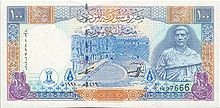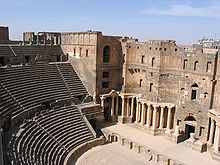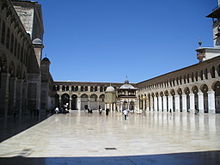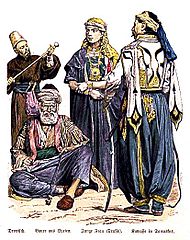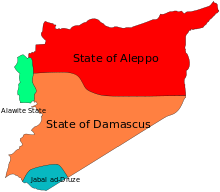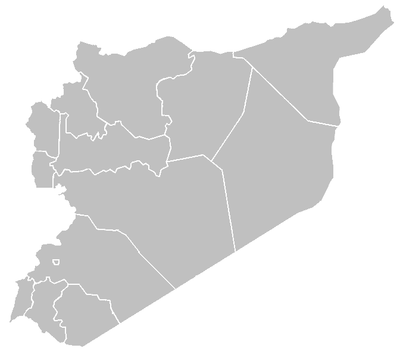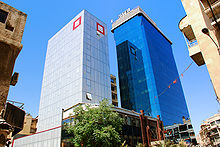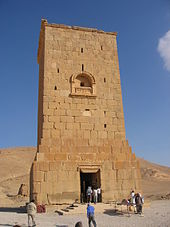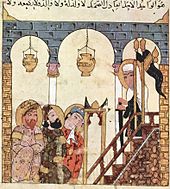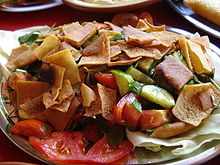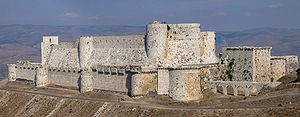- Syria
-
This article is about the modern state of Syria. For other uses, see Syria (disambiguation).
Syrian Arab Republic الجمهورية العربية السورية
Al-Jumhūriyyah al-ʿArabiyyah as-Sūriyyah

Flag Coat of arms Anthem: Homat el Diyar
Guardians of the LandCapital Damascus
33°30′N 36°18′E / 33.5°N 36.3°EOfficial language(s) Arabic1 Demonym Syrian Government Single-party state - President Bashar al-Assad Legislature People's Council Independence - From France 17 April 1946 Area - Total 185,180 km2 (88th)
71,479 sq mi- Water (%) 1.1 Population - 2011 estimate 22,717,417[1] (53rd) - Density 118.3/km2 (101st)
306.5/sq miGDP (PPP) 2011 estimate - Total $105.238 billion[2] - Per capita US$5,043[2] GDP (nominal) 2010 estimate - Total US$60.210 billion[2] - Per capita US$2,958[2] HDI (2010)  0.589[3] (medium) (111th)
0.589[3] (medium) (111th)Currency Syrian pound ( SYP)Time zone EET (UTC+2) - Summer (DST) EEST (UTC+3) Drives on the Right Internet TLD .sy, سوريا. Calling code 9632 1 Arabic is the official language; spoken languages and varieties are: Syrian Arabic, North Mesopotamian Arabic, Kurmanji Kurdish, Armenian, Aramaic, Circassian, Turkish[4] 2 02 from Lebanon Syria (/ˈsɪriə/ (
 listen) si-ree-ə; Arabic: سورية Sūriyya or سوريا Sūryā; Syriac: ܣܘܪܝܐ; Kurdish: Sûrî), officially the Syrian Arab Republic (Arabic: الجمهورية العربية السورية Al-Jumhūriyyah al-ʿArabiyyah as-Sūriyyah
listen) si-ree-ə; Arabic: سورية Sūriyya or سوريا Sūryā; Syriac: ܣܘܪܝܐ; Kurdish: Sûrî), officially the Syrian Arab Republic (Arabic: الجمهورية العربية السورية Al-Jumhūriyyah al-ʿArabiyyah as-Sūriyyah  Arabic pronunciation (help·info)), is a country in Western Asia, bordering Lebanon and the Mediterranean Sea to the West, Turkey to the north, Iraq to the east, Jordan to the south, and Israel to the southwest.
Arabic pronunciation (help·info)), is a country in Western Asia, bordering Lebanon and the Mediterranean Sea to the West, Turkey to the north, Iraq to the east, Jordan to the south, and Israel to the southwest.In English, the name Syria was formerly synonymous with the Levant, known in Arabic as Sham, while the modern state encompasses the sites of several ancient kingdoms and empires, including the Eblan civilization of the third millennium BC. In the Islamic era, its capital city, Damascus, the oldest continuously inhabited city in the world,[5] was the seat of the Umayyad Caliphate, and a provincial capital of the Mamluk Sultanate of Egypt.
The population of Syria is 74% Sunni Muslim, with a 13% Shia Muslim population, 10% Christian and 3% Druze. Combined, some 90% of the Syrian population is Muslim, which largely includes Arabs and significant minorities of Kurds, and Circassians. Some 10% are Christians, which mainly includes ethnic Assyrians, but also Arab Christians, and Armenians. Major ethnic minorities include Kurdish (10%), Assyrian/Syriac, Armenian, Turkmen and Circassian populations, while the majority is Arab (90%).[6]
The modern Syrian state was established after the First World War as a French mandate, and represented the largest Arab state to emerge from the formerly Ottoman-ruled Arab Levant. It gained independence in April 1946, as a parliamentary republic. The post-independence period was tumultuous, and a large number of military coups and coup attempts shook the country in the period 1949–1971. Between 1958-1961, Syria entered a brief union with Egypt, which was terminated by a military coup in Syria. Syria was under Emergency Law from 1963–2011, effectively suspending most constitutional protections for citizens, and its system of government is considered to be non-democratic.[7] Bashar al-Assad has been the current president since 2000 and was preceded by his father Hafez al-Assad, who was in office since 1971.[8] The Syrian government is currently facing massive protests as part of the Arab Spring, and one government, that of Libya, has de-recognised it in favor of the opposition Syrian National Council.[9]
Contents
Etymology
Main article: Name of SyriaThe name Syria is derived from the ancient Greek name for Syrians: Σύριοι, Sýrioi, or Σύροι, Sýroi, which the Greeks applied without distinction to the Assyrians.[10][11] A number of modern scholars argued that the Greek word related to the cognate Ἀσσυρία, Assyria, ultimately derived from the Akkadian Aššur.[12] Others believed that it was derived from Siryon, the name that the Sidonians gave to Mount Hermon.[13] However, the discovery of the Çineköy inscription in 2000 seems to support the theory that the term Syria does indeed derive from Assyria.
The area designated by the word has changed over time. Classically, Syria lies at the eastern end of the Mediterranean, between Egypt and Arabia to the south and Cilicia to the north, stretching inland to include parts of Iraq, and having an uncertain border to the northeast that Pliny the Elder describes as including, from west to east, Commagene, Sophene, and Adiabene.[14]
By Pliny's time, however, this larger Syria had been divided into a number of provinces under the Roman Empire (but politically independent from each other): Judaea, later renamed Palaestina in AD 135 (the region corresponding to modern day Palestine, and Jordan) in the extreme southwest, Phoenicia corresponding to Lebanon, with Damascena to the inland side of Phoenicia, Coele-Syria (or "Hollow Syria") south of the Eleutheris river, and Iraq.[15]
Geography
Main article: Geography of Syria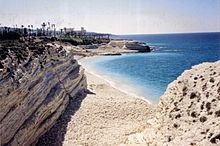 Burj Islam, a well known beach just north of Latakia.
Burj Islam, a well known beach just north of Latakia.
Syria lies between latitudes 32° and 38° N, and longitudes 35° and 43° E. It consists mostly of arid plateau, although the northwest part of the country bordering the Mediterranean is fairly green. The Northeast of the country "Al Jazira" and the South "Hawran" are important agricultural areas.[16] The Euphrates, Syria's most important river, crosses the country in the east. It is considered to be one of the fifteen states that comprise the so-called "Cradle of civilization".[17]
The climate in Syria is dry and hot, and winters are mild. Because of the country's elevation, snowfall does occasionally occur during winter.[16] Petroleum in commercial quantities was first discovered in the northeast in 1956. The most important oil fields are those of Suwaydiyah, Qaratshui, Rumayian, and Tayyem, near Dayr az–Zawr. The fields are a natural extension of the Iraqi fields of Mosul and Kirkuk. Petroleum became Syria's leading natural resource and chief export after 1974. Natural gas was discovered at the field of Jbessa in 1940.[18]
History
Main article: History of Syria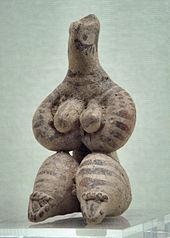 Female figurine, Syria, 5000 BCE. Ancient Orient Museum.
Female figurine, Syria, 5000 BCE. Ancient Orient Museum.
Since approximately 10,000 BCE Syria was one of centers of Neolithic culture (PPNA) where agriculture and cattle breeding appeared for the first time in the world. The following Neolithic period (PPNB) is represented by rectangular houses of Mureybet culture. At the time of the pre-pottery Neolithic people used vessels made of stone, gyps and burnt lime (Vaiselles blanches). Finds of obsidian tools from Anatolia are evidences of early trade relations. Cities of Hamoukar and Emar played an important role during the late Neolithic and Bronze Age.
Archaeologists have demonstrated that civilization in Syria was one of the most ancient on earth. Around the excavated city of Ebla in northern Syria, an Italian mission led by Prof. Paolo Matthiae discovered in 1975, a great Semitic empire spread from the Red Sea north to Anatolia and east to Iraq from 2500 to 2400 BC Ebla appears to have been founded around 3000 BCE and gradually built its empire through trade with the cities of Sumer and Akkad, as well as with peoples to the northwest. Gifts from Pharaoh found during excavations confirm Ebla's contact with Egypt. Scholars believe the language of Ebla to be among the oldest known written Semitic languages. The Eblan civilization was likely conquered by Sargon of Akkad around 2260 BC; the city was restored as the nation of the Amorites a few centuries later and flourished through the early second millennium BC until conquered by the Hittites.
During the second millennium BCE, Syria was occupied successively by Canaanites(Phoenicians) and Arameans as part of the general disruptions associated with the Sea Peoples; the Phoenicians settled along the coastline of these areas as well as in the west (Now Lebanon and the current Syrian coast), in the area already known for its cedars. Egyptians, Sumerians, Assyrians, Babylonians, and Hittites variously occupied the strategic ground of Syria during this period, as it was a marchland between their various empires. Eventually the Persians took control of Syria as part of their general control of Southwest Asia; this control transferred to the Greeks after Alexander the Great's conquests and thence to the Romans and the Byzantines.
In 83 BC Syria fell under the rule of Tigranes the Great; the King of Armenia. The Armenians maintained a rule of 13 years over Syria, which was finally turned into a Roman Province in 64 BC.
Ebla civilization
Around the excavated city of Ebla near Idlib city in northern Syria, discovered in 1975, a great Semitic empire spread from the Red Sea north to Anatolia and east to Iraq from 2500 to 2400 BCE. Ebla appears to have been founded around 3000 BC, and gradually built its empire through trade with the cities of Sumer and Akkad, as well as with peoples to the northwest.[19] Gifts from Pharaohs, found during excavations, confirm Ebla's contact with Egypt. Scholars believe the language of Ebla to be among the oldest known written Semitic languages, designated as Paleo-Canaanite.[19]
However, more recent classifications of the Eblaite language has shown that it was an East Semitic language, closely related to the Akkadian language.[20] The Eblan civilization was likely conquered by Sargon of Akkad around 2260 BC; the city was restored, as the nation of the Amorites, a few centuries later, and flourished through the early second millennium BC until conquered by the Hittites.[21]
Antiquity and early Christian era
Main articles: Phoenicia, Canaan, Aram Damascus, Achaemenid Empire, Seleucid Empire, and Syria (Roman province) Philippus Araps, Roman Emperor
Philippus Araps, Roman Emperor
During the second millennium BC, Syria was occupied successively by Canaanites, Phoenicians, and Arameans as part of the general disruptions and exchanges associated with the Sea Peoples. The Phoenicians settled along the coast of Northern Canaan (Lebanon), which was already known for its towering cedars. Egyptians, Sumerians, Assyrians, Babylonians and Hittites variously occupied the strategic ground of Syria during this period; the land between their various empires being marsh.[19]
Eventually, the Persians took Syria as part of their hegemony of Southwest Asia; this dominion was transferred to the Ancient Macedonians after Alexander the Great's conquests and the Seleucid Empire. The capital of this Empire (founded in 312 BC) was situated at Antioch, part of historical Syria, but just inside the Turkish border today. But the Seleucid Empire was essentially just one long slow period of decline, and Pompey the Great captured Antioch in 64 BC, turning Syria into a Roman province. Thus control of this region passed to the Romans and then the Byzantines.[19]
In the Roman Empire period, the city of Antioch was the third largest city in the empire after Rome and Alexandria. With an estimated population of 500,000 at its peak, Antioch was one of the major centers of trade and industry in the ancient world. The population of Syria during the heyday of the empire was probably not exceeded again until the 19th century. Syria's large and prosperous population made Syria one of the most important of the Roman provinces, particularly during the 2nd and 3rd centuries (AD).[22]
The Roman Emperor Alexander Severus, who was emperor from 222 to 235, was Syrian. His cousin Elagabalus, who was emperor from 218 to 222, was also Syrian and his family held hereditary rights to the high priesthood of the sun god El-Gabal at Emesa (modern Homs) in Syria. Another Roman emperor who was a Syrian was Philip the Arab (Marcus Julius Philippus), emperor from 244 to 249.[22]
Syria is significant in the history of Christianity; Saul of Tarsus was converted on the Road to Damascus, thereafter being known as the Apostle Paul, and emerged as a significant figure in the first organized Christian Church at Antioch in ancient Syria, from which he left on many of his missionary journeys. (Acts 9:1–43 )
 The desert city of Palmyra, whose ruins are now a UNESCO World Heritage Site, grew large in the Syrian desert in the 1st and 2nd centuries (A.D.).
The desert city of Palmyra, whose ruins are now a UNESCO World Heritage Site, grew large in the Syrian desert in the 1st and 2nd centuries (A.D.).
Islamic era
Main articles: Umayyad Caliphate, Abbasid Caliphate, Ayyubid dynasty, Zengid dynasty, and Hamdanid dynasty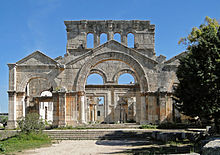 Church of Saint Simeon Stylites is considered to be one of the oldest surviving churches in the world.
Church of Saint Simeon Stylites is considered to be one of the oldest surviving churches in the world.
By AD 640, Syria was conquered by the Rashidun army led by Khalid ibn al-Walid, resulting in the area's becoming part of the Islamic empire. In the mid-7th century, the Umayyad dynasty, then rulers of the empire, placed the capital of the empire in Damascus. Syria was divided into four districts: Damascus, Homs, Palestine and Jordan. The Islamic empire stretched from Spain and Morocco to India and parts of Central Asia; thus Syria prospered economically, being the capital of the empire. Early Ummayad rulers such as Abd al-Malik and Al-Walid I constructed several splendid palaces and mosques throughout Syria, particularly in Damascus, Aleppo and Homs.
There was great toleration of Christians in this era and several held governmental posts. The country's power dramatically declined during later Ummayad rule; mainly due to the totalitarianism and corruption spread among the empire's leaderships, conflict between its general staff, and the successive revolutions by the oppressed and miserable groups. As one Ummayad chieftain responded to a question about the reasons of the decline of their empire: "Rather visiting what needed to be visited, we were more interested in the pleasure and enjoyment of life; we oppressed our people until they gave up and sought relief from us, [...] we trusted our ministers who favoured their own interests and kept secrets from us, and we unhurriedly rewarded our soldiers that we lost their obedience to our enemies."[citation needed]
Ummayad dynasty was then overthrown by the Abbasid dynasty in 750, who moved the capital of empire to Baghdad. Arabic — made official under Ummayad rule — became the dominant language, replacing Greek and Aramaic in the Abbasid era. In 887, the Egypt-based Tulunids annexed Syria from the Abbasids, and were later replaced by once the Egypt-based Ikhshidids and later by the Hamdanids originating in Aleppo founded by Sayf al-Dawla.[23]
Sections of the coastline of Syria were briefly held by Frankish overlords during the Crusades of the 12th century, and were known as the Crusader state of the Principality of Antioch. The area was also threatened by Shi'a extremists known as Assassins (Hassassin). In 1260, the Mongols arrived, led by Hulegu with an army 100,000 strong, destroying cities and irrigation works. Aleppo fell in January 1260, and Damascus in March, but then Hulegu needed to break off his attack to return to China to deal with a succession dispute.
The command of the remaining Mongol troops was placed under Kitbuqa, a Christian Mongol. A few months later, the Mamluks arrived with an army from Egypt, and defeated the Mongols in the Battle of Ain Jalut, in Galilee. In addition to the sultanate's capital in Cairo, the Mamluk leader, Baibars, made Damascus a provincial capital, with the cities linked by a mail service that traveled by both horses and carrier pigeons. When Baibars died, his successor was overthrown, and power was taken by Qalawun. In the meantime, an emir named Sunqur al-Ashqar had tried to declare himself ruler of Damascus, but he was defeated by Qalawun on 21 June 1280, and fled to northern Syria.
 Citadel of Aleppo is considered to be one of the oldest and largest castles in the world.
Citadel of Aleppo is considered to be one of the oldest and largest castles in the world.
Al-Ashqar, who had married a Mongol woman, appealed for help from the Mongols, and in 1281, they arrived with an army of 50,000 Mongols, and 30,000 Armenian, Georgian, and Turkish auxiliaries, along with Al-Ashqar's rebel force. The Mongols of the Ilkhanate took the city, but Qalawun arrived with a Mamluk force, persuaded Al-Ashqar to switch sides and join him, and they fought against the Mongols on 29 October 1281, in the Second Battle of Homs, a close battle that resulted in the death of the majority of the combatants but was finally won by the Mamluks.[24]
In 1400, Timur Lenk, or Tamerlane, invaded Syria, sacked Aleppo and captured Damascus after defeating the Mamluk army. The city's inhabitants were massacred, except for the artisans, who were deported to Samarkand.[25][26] It was during the conquests of Timur that the indigenous Christian population of Syria began to suffer under greater persecutions.
By the end of the 15th century, the discovery of a sea route from Europe to the Far East ended the need for an overland trade route through Syria. In 1516, the Ottoman Empire invaded the Mamluk Sultanate of Egypt, conquering Syria, and incorporating it into its empire, before conquering Egypt itself the following year. From that time until the 20th century, Syria found itself largely apart from, and ignored by, world affairs.
Ottoman era
Main article: Ottoman SyriaThe Syrian economy did not flourish under the Ottomans. At times attempts were made to rebuild the country that had been shattered by the Mongols, but on the whole Syria remained poor. The population decreased by nearly 30%, and hundreds of villages virtually disappeared into the desert. At the end of the 18th century only one-eighth of the villages formerly on the register of the Aleppo pashalik (domain of a pasha) were still inhabited.[27]
Two allied diplomats (Frenchman François Georges-Picot and Briton Mark Sykes) secretly agreed, long before the end of the war, how to split the Ottoman Empire into several zones of influence. With the end of World War I and the defeat of the Ottoman Empire as an ally of Germany, plans by the Entente powers to dissolve this Ottoman territory could then begin.
The Sykes-Picot Agreement of 1916 set the fate of modern Southwest Asia for the coming century; providing France with the northern zone (Syria, including what would become the state of Lebanon), and the United Kingdom with the southern one (Iraq and later, after renegotiations in 1917, Palestine (including what would become the state of Jordan) – 'to secure daily transportation of troops from Haifa to Baghdad' – agreement n° 7).
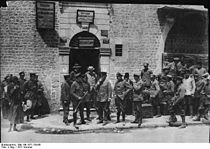 German troops in Aleppo, summer of 1917.
German troops in Aleppo, summer of 1917.
The two territories were separated by only a straight border line from Jordan to Iran. But early discoveries of oil in the region of Mosul just before the end of the war led to yet another negotiation with France in 1918 to cede this region to 'Zone B', or the British zone of influence. The borders between the 'Zone A' and 'Zone B' have not changed from 1918 to this date. Since 1920, the two sides have been recognized internationally under mandate of the League of Nations by the two dominant countries: France and the United Kingdom.[28]
French Mandate
Main article: French Mandate of Syria and LebanonIn 1920, a short-lived independent Kingdom of Syria was established under Faisal I of the Hashemite family, who later became the King of Iraq. However, his rule over Syria ended after only a few months, following the clash between his Syrian Arab forces and regular French forces at the Battle of Maysalun. French troops occupied Syria later that year after the San Remo conference proposed that the League of Nations put Syria under a French mandate.[29]
In 1925, Sultan al-Atrash led a revolt that broke out in the Druze Mountain and spread to engulf the whole of Syria and parts of Lebanon. This is considered one of the most important revolutions against the French mandate, as it encompassed the whole of Syria and witnessed fierce battles between rebel and French forces.
On August 23, 1925, Sultan Pasha al-Atrash officially declared revolution against France, and soon fighting erupted in Damascus, Homs and Hama. Al-Atrash won several battles against the French at the beginning of revolution, notably the Battle of Al-Kabir on July 21, 1925, the Battle of Al-Mazra'a on August 2, 1925, and the battles of Salkhad, Almsifarh and Suwayda.
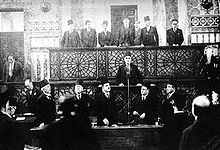 The inauguration of President Hashim al-Atassi in 1936
The inauguration of President Hashim al-Atassi in 1936
After resistance victories against the French, France sent thousands of troops to Syria and Lebanon from Morocco and Senegal, equipped with modern weapons; the rebels were lightly armed. This dramatically altered the results and allowed the French to regain many cities, although resistance lasted until the spring of 1927. The French sentenced Sultan al-Atrash to death, but he had escaped with the rebels to Transjordan and was eventually pardoned. He returned to Syria in 1937 after the signing of the Syrian-French Treaty. He was met with a huge public reception.
Syria and France negotiated a treaty of independence in September 1936, and Hashim al-Atassi, who was Prime Minister under King Faisal's brief reign, was the first president to be elected under a new constitution, effectively the first incarnation of the modern republic of Syria. However, the treaty never came into force because the French Legislature refused to ratify it. With the fall of France in 1940 during World War II, Syria came under the control of Vichy France until the British and Free French occupied the country in the Syria-Lebanon campaign in July 1941. Syria proclaimed its independence again in 1941, but it was not until 1 January 1944 that it was recognised as an independent republic. Continuing pressure from Syrian nationalist groups and British pressure forced the French to evacuate their troops in April 1946, leaving the country in the hands of a republican government that had been formed during the mandate.[18]
Independence, instability and economic growth
Although rapid economic development followed the declaration of independence, Syrian politics from independence through the late 1960s were marked by upheaval. Between 1946 and 1956, Syria had 20 different cabinets and drafted four separate constitutions. In 1948, Syria was involved in the Arab-Israeli War, aligning with the other local Arab states who were attempting to prevent incorporation of Palestine into the State of Israel.[30] The Syrian army was pressed out of most of Palestine, but fortified their strongholds on the Golan Heights and managed to keep their old borders and some additional territory (this was converted into "supposed" demilitarized zones under UN supervision ; the status of these territories have proved a stumbling-block for Syrian-Israeli negotiations). It was during this period that many Syrian Jews, who faced growing discrimination, emigrated from the country, as part of Jewish exodus from Arab countries.
 President Adib Shishakli
President Adib Shishakli
The humiliating defeat suffered by the army was one of several trigger factors for the March 1949 Syrian coup d'état by Col. Husni al-Za'im, in what has been described as the first military overthrow of the Arab World[30] since the start of the Second World War. This was soon followed by another overthrow, by Col. Sami al-Hinnawi, who was himself quickly deposed by Col. Adib Shishakli, all within the same year.[30]
After exercising influence behind the scenes for some time, dominating the ravaged parliamentary scene, Shishakli launched a second overthrow in 1951, entrenching his rule and eventually abolishing multipartyism altogether. Only when President Shishakli was himself overthrown in a 1954 overthrow was the parliamentary system restored, but it was fundamentally undermined by continued political maneuvering supported by competing factions in the military.[30]
By this time, civilian politics had been largely gutted of meaning, and power was increasingly concentrated in the military and security establishment, which had now proved itself to be the only force capable of seizing and, perhaps, keeping power.[30] Parliamentary institutions remained weak and ineffectual, dominated by competing parties representing the landowning elites and various Sunni urban notables, while economy and politics were mismanaged, and little done to better the role of Syria's peasant majority. That, as well as the influence of Nasserism and other nationalist and anti-imperial ideologies, created fertile ground for various Arab nationalist, Syrian nationalist, and socialist movements, who represented disaffected elements of society, notably including the religious minorities, and demanded radical reform.[30]
During the Suez Crisis of 1956, after the invasion of Egypt by Israel, Britain, and France, martial law was declared in Syria. The November 1956 attacks on Iraqi pipelines were in retaliation for Iraq's joining of the Baghdad Pact. In early 1957 Iraq advised Egypt and Syria against a conceivable takeover of Jordan.[31]
In November 1956, Syria signed a pact with the Soviet Union, providing a foothold for Communist influence within the government in exchange for planes, tanks, and other military equipment being sent to Syria.[30] With this increase in the strength of Syrian military technology worried Turkey, as it seemed feasible that Syria might attempt to retake İskenderun, a matter of dispute between Syria and Turkey. On the other hand, Syria and the Soviet Union accused Turkey of massing its troops at the Syrian border. During this standoff, Communists gained more control over the Syrian government and military. Only heated debates in the United Nations (of which Syria was an original member) lessened the threat of war.[32]
Syria's political instability during the years after the 1954 overthow, the parallelism of Syrian and Egyptian policies, and the appeal of Egyptian President Gamal Abdal Nasser's leadership in the wake of the Suez Crisis created support in Syria for union with Egypt.[30] On 1 February 1958, Syrian President Shukri al-Quwatli and Nasser announced the merging of the two states, creating the United Arab Republic, and all Syrian political parties, as well as the communists therein, ceased overt activities.[18]
The union was not a success, however.[30] Following a military overthrow led by Abd al-Karim al-Nahlawi on 28 September 1961, Syria seceded, re-establishing itself as the Syrian Arab Republic. Instability characterized the next 18 months, with various overthrows culminating with 8 March 1963 coup, resulting in installation by leftist Syrian Army officers of the National Council of the Revolutionary Command (NCRC), a group of military and civilian officials who assumed control of all executive and legislative authority. The takeover was engineered by members of the Arab Socialist Resurrection Party (Ba'ath Party), which had been active in Syria and other Arab countries since the late 1940s. The new cabinet was dominated by Ba'ath members.[18][30]
The Baath takeover in Syria followed a Baath overthrow in Iraq the previous month. The new Syrian Government explored the possibility of federation with Egypt and with Baath-controlled Iraq.[30] An agreement was concluded in Cairo on 17 April 1963, for a referendum on unity to be held in September 1963. However, serious disagreements among the parties soon developed, and the tripartite federation failed to materialize. Thereafter, the Baath government in Syria and Iraq began to work for bilateral unity. These plans foundered in November 1963, when the Baath government in Iraq was overthrown.
In May 1964, President Amin Hafiz of the NCRC promulgated a provisional constitution providing for a National Council of the Revolution (NCR), an appointed legislature composed of representatives of mass organizations—labour, peasant, and professional unions—a presidential council, in which executive power was vested, and a cabinet. On 23 February 1966, a group of army officers carried out a successful, intra-party overthrow, imprisoned President Hafiz, dissolved the cabinet and the NCR, abrogated the provisional constitution, and designated a regionalist, civilian Baath government on 1 March.[30] The leaders of the overthrow described it as a "rectification" of Baath Party principles.[30]
We shall never call for nor accept peace. We shall only accept war. We have resolved to drench this land with your blood. To oust you aggressors, to throw you into the sea.[33]—Hafez al-Assad, then Syrian Defence Minister, 24 May 1966When Nasser closed the Gulf of Aqaba to Eilat-bound ships, the Baath government supported the Egyptian leader and amassed troops in the strategic Golan Heights. Syria sponsored Palestinian raids into Israel[34] and Syrian artillery repeatedly bombed Israeli civilian communities from positions on the Golan Heights[35] Concerning the raids on Israel's territory, Syria claimed that it could not be held responsible for the activities of El-Fatah and El-Asefa, nor for the rise of Palestinian organizations.[36]
Conflicts also arose over different interpretations of the legal status of the Demilitarized Zone. Israel maintained that it had sovereign rights over the zone, allowing the civilian use of farmland. Syria and the UN maintained that no party had sovereign rights over the zone.[37] Israel was accused by Syria of cultivating lands in the Demilitarized Zone, using armored tractors backed by Israel forces. Syria claimed that the situation was the result of an Israeli aim to increase tension so as to justify large-scale aggression, and to expand its occupation of the Demilitarized Zone by liquidating the rights of Arab cultivators.[38]
Conflict over the cultivation of disputed lands sparked into April 7 prewar aerial clashes between Israel and Syria.[39]
The Israeli defense minister Moshe Dayan said in a 1976 interview that Israel provoked more than 80% of the clashes with Syria.[40][41]
After Israel launched a preemptive strike on Egypt to begin the June 1967 war, Syria joined the battle against Israel as well. In the final days of the war, after having captured the Sinai Peninsula and Gaza Strip from Egypt, as well as the West Bank and eastern Jerusalem from Jordan, Israel turned its attention to Syria, capturing the entire Golan Heights in under 48 hours.[42]
Conflict developed between an extremist military wing and a more moderate civilian wing of the Baath Party. The 1970 retreat of Syrian forces sent to aid the PLO during the "Black September" hostilities with Jordan reflected this political disagreement within the ruling Baath leadership.[43] By 13 November 1970, Minister of Defense Hafez al-Assad was solidly established as the strongman of the government, when he effected a bloodless military overthrow ("The Corrective Movement").[44]
Baath Party rule under Hafez al-Assad, 1970–2000
See also: Baath Party, Hafez al-Assad, and 1970 Syrian Corrective Revolution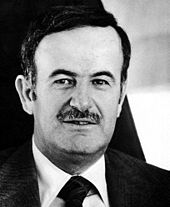 Hafez al-Assad, former president of Syria
Hafez al-Assad, former president of Syria
Upon assuming power, Hafez al-Assad moved quickly to create an organizational infrastructure for his government and to consolidate control. The Provisional Regional Command of Assad's Arab Baath Socialist Party nominated a 173-member legislature, the People's Council, in which the Baath Party took 87 seats. The remaining seats were divided among "popular organizations" and other minor parties. In March 1971, the party held its regional congress and elected a new 21-member Regional Command headed by Assad.
In the same month, a national referendum was held to confirm Assad as President for a 7-year term. In March 1972, to broaden the base of his government, Assad formed the National Progressive Front, a coalition of parties led by the Baath Party, and elections were held to establish local councils in each of Syria's 14 governorates. In March 1973, a new Syrian constitution went into effect followed shortly thereafter by parliamentary elections for the People's Council, the first such elections since 1962.[18] The 1973 Constitution defines Syria officially as a secular socialist state with Islam recognised as majority religion.
On 6 October 1973, Syria and Egypt began the Yom Kippur War by staging a surprise attack against Israeli forces returning the Syrian Golan Heights and the Egyptian Sinai Peninsula. After early successes, the Israeli military reversed the initial Syrian gains, pushing the Syrian army out of the Golan and invaded into Syrian territory beyond the 1967 border. As a result, Israel continued to occupy the Golan Heights as part of the Israeli-occupied territories.[45]
In early 1976, the Lebanese civil war was going poorly for the Maronite Christians. Following a request from the Maronite dominated Lebanese government with the approval of the Arab league,[citation needed] Syria sent 40,000 troops into the country ostensibly to prevent them from being overrun, but abruptly switched sides soon thereafter and became embroiled in the Lebanese Civil War, beginning the 30 year Syrian military presence. Many crimes in Lebanon, including the assassinations of Rafik Hariri, Kamal Jumblat and Bachir Gemayel were attributed to the Syrian forces and intelligence services but these were never proven.[46] Over the following 15 years of civil war, Syria fought for control over Lebanon, and attempted to undermine Israel in southern Lebanon, through extensive use of proxy militias. Many saw the Syrian Army's presence in Lebanon as an occupation, especially following the end of the civil war in 1990, after the Syrian-sponsored Taif Agreement. Syria then remained in Lebanon until 2005, exerting a heavy-handed influence over Lebanese politics that was deeply resented by many. Following the assassination of the popular former Lebanese Prime Minister Rafik Hariri, blamed on Syria, pressure was put to bear on Syria to withdraw their forces from Lebanon. On April 26, 2005 the bulk of the Syrian forces withdrew from Lebanon[47] but some of its intelligence operatives remained, drawing further international rebuke.[48]
About one million Syrian workers came into Lebanon after the war ended to find jobs in the reconstruction of the country.[49] Syrian workers were preferred over Palestinian and Lebanese workers because they could be paid lower wages. In 1994, under pressure from Damascus[citation needed], the Lebanese government controversially granted citizenship to over 200,000 Syrian residents in the country.[50] (For more on these issues, see Demographics of Lebanon)
The authoritarian government was not without its critics, though open dissent was repressed. A serious challenge arose in the late 1970s, however, from fundamentalist Sunni Muslims, who reject the basic values of the secular Baath program and object to rule by the Alawis, whom they consider heretical. From 1976 until its suppression in 1982, the arch-conservative Muslim Brotherhood led an armed insurgency against the government. In response to an attempted uprising by the brotherhood in February 1982, the government crushed the fundamentalist opposition centered in the city of Hama, leveling parts of the city with artillery fire and leaving between 10,000 and 25,000 people either dead or wounded, mostly civilians (see Hama massacre).[51] The Syrian government's actions at Hama have been described as possibly being "the single deadliest act by any Arab government against its own people in the modern Middle East".[52] Since then, public manifestations of anti-government activity have been limited.[18]
Syria's 1990 participation in the U.S.-led multinational coalition aligned against Saddam Hussein marked a dramatic watershed in Syria's relations both with other Arab states and with the Western world. Syria participated in the multilateral Southwest Asia Peace Conference in Madrid in October 1991, and during the 1990s engaged in direct, face-to-face negotiations with Israel. These negotiations failed, and there have been no further direct Syrian-Israeli talks since President Hafez al-Assad's meeting with then President Bill Clinton in Geneva in March 2000.[53]
Under Bashar al-Assad
See also: Bashar al-Assad Syrian president Bashar al-Assad (left) with Brazilian then-president Lula da Silva (right), 2010
Syrian president Bashar al-Assad (left) with Brazilian then-president Lula da Silva (right), 2010
Hafez al-Assad died on 10 June 2000, after 30 years in power. Immediately following al-Assad's death, the Parliament amended the constitution, reducing the mandatory minimum age of the President from 40 to 34. This allowed his son, Bashar al-Assad, to become legally eligible for nomination by the ruling Baath party. On 10 July 2000, Bashar al-Assad was elected President by referendum in which he ran unopposed, garnering 97.29% of the vote, according to Syrian Government statistics.[18]
Basher's election in the summer of 2000 saw the birth of the Damascus Spring and hopes of reform. The period was characterized by the emergence of numerous political forums or salons where groups of like minded people met in private houses to debate political and social issues. The phenomenon of salons spread rapidly in Damascus and to a lesser extent in other cities. Political activists, such as, Riad Seif, Haitham al-Maleh, Kamal al-Labwani, Riyad al-Turk, and Aref Dalila were important in mobilizing the movement.[54] The most famous of the forums were the Riad Seif Forum and the Jamal al-Atassi Forum. Pro-democracy activists mobilized around a number of political demands, expressed in the "Manifesto of the 99". However, by autumn 2001, the authorities had suppressed the movement, imprisoning some of the leading intellectuals who had called for democratic elections and a campaign of civil disobedience.[55] Renewed opposition activity occurred in October 2005 when activist Michel Kilo launched with leading opposition figures the Damascus Declaration, which criticized the Syrian government as "authoritarian, totalitarian and cliquish" and called for democratic reform.[56] Although the Damascus Spring lasted for a short period, its effects still echo during the political, cultural and intellectual debates in Syria today.
Although Bashar al-Assad said he would reform, the reforms have been limited to some market reforms.[8][57][58]
Over the years the authorities have tightened Internet censorship with laws such as forcing Internet cafes to record all the comments users post on chat forums.[59] While the authorities have relaxed rules so that radio channels can now play Western pop music, websites such as Wikipedia, Youtube, Facebook and Amazon have been blocked.[60]
On 5 October 2003, Israel bombed a site near Damascus, charging it was a terrorist training facility for members of Islamic Jihad. The raid was in retaliation for the bombing of a restaurant in the Israeli town of Haifa that killed 19. Islamic Jihad said the camp was not in use; Syria said the attack was on a civilian area.[61]
The United States moved closer to imposing sanctions on Syria, following the adoption of the Syria Accountability Act by the House of Representatives International Relations committee.[62] Hamas, Islamic Jihad and Hezbollah, all included in what the EU and the U.S view as terrorist groups, all take refuge and enjoy strong relationships with the Syrian government.
Following 2004 Al-Qamishli riots, the Syrian Kurds protested in Brussels, Geneva, in Germany, at the US and UK embassies, and in Turkey. The protesters pledged against violence in north-east Syria starting Friday, 12 March 2004, and reportedly extending over the weekend resulting in several deaths, according to reports. The Kurds allege the Syrian government encouraged and armed the attackers. Signs of rioting were seen in the towns of Qameshli and Hassakeh.[63]
In 2005, under heavy international pressure, Syria withdrew 14,000 troops and intelligence agents out of Lebanon.[64]
The authorities maintain close ties to Iran. On September 6, 2007, Israeli jet fighters carried out Operation Orchard against a suspected nuclear reactor under construction by North Korean technicians.[65]
In April, 2008, President Assad told a Qatari newspaper that Syria and Israel had been discussing a peace treaty for a year, with Turkey acting as a mediator. This was confirmed in May, 2008, by a spokesman for Israeli Prime Minister Ehud Olmert. The status of the Golan Heights, a major obstacle to a peace treaty, is being discussed. President Assad was quoted in The Guardian as blaming the United States.[66]
2011 Syrian Uprising
Main article: 2011 Syrian uprisingProtests in Syria started on 26 January and were influenced by other protests in the region; on the same day, one case of self-immolation was reported. Protesters have been calling for political reforms and the reinstatement of civil rights, as well as an end to the state of emergency which has been in place since 1963.[67] One attempt at a "day of rage" was set for 4 – 5 February, though it ended up uneventful.[68][69]
 Large protests in Al-Assy square in Hama
Large protests in Al-Assy square in Hama
On March 15, demonstrations took place in many cities across Syria. Thousands of protestors gathered in al-Hasakah, Aleppo, Damascus, Daraa, Deir ez-Zor, and Hama.[70][71][72][73] Recently released politician Suhair Atassi became an unofficial spokesperson for the "Syrian revolution"[74][75][76][77] Atassi paid tribute to "the Syrian people who took the initiative ahead of the opposition," recalling the popular uprisings that shook Tunisia and Egypt. After the first day of the protests there were reports of approximately 3000 arrests and a few "martyrs", but there are no official figures on the number of deaths.[78]
On 16 March, Syrian authorities forcibly dispersed a demonstration in front of the Syrian Interior Ministry. al-Arabiya reported that protesters were a mix of activists and jurists, writers, journalists, young academics and family members to people detained in Syrian prisons.[79][80][81] The security forces arrested a number of protestors, Al Jazeera reported 25,[82] while Al Arabiya said 32[83] including activist and lawyer Suhair Atassi and Kamal Cheikho, an activist who had been released two days earlier.[84][85][86] Mohamed al-Ali, a spokesman for the Syrian Interior authority denied that any demonstrations have happened in Syria and that the Facebook campaign has been proved unsuccessful. According to the spokesperson, the "claimed protests" consisted of a few people who were "hiding" among the already packed souq (i.e. market) and tried to make it look like a demonstration.[87] In another statement, he went further by saying that the demonstration that took place outside the Interior authority was actually in support of President Bashar al-Assad.[88]
On 18 March, thousands of protesters in several Syrian cities took to the streets after the Friday prayers and chanted "God, Syria, Freedom, that is enough", challenging the classical pro-regime slogan "God, Syria, Bashar, that is enough". In Damascus, security forces broke into the Omayyad Mosque and violently attacked protesters. Several people were injured, and several others were arrested. In the southern city of Daraa, people chanted against Rami Makhlouf, the cousin of the Syrian president. The regime replied by sending helicopters and water cannons to confront the protesters. At least three people were killed by security forces.[89]
On 22 March, as a result of the protests, the Governor of Daraa was fired,[90] but this did not satisfy the protesters. Demonstrations increased, and on 24 March, it was reported that more than a hundred had been killed [91] in marches at Daraa that exceeded 20,000 participants.
On 29 March, the entire Syrian cabinet was asked to resign by the president.[92] Adel Safar was named the new prime minister and his new cabinet was sworn into office on 14 April 2011. The Emergency Law was rescinded on 21 April 2011.
Since 25 April city of Deraa is under a siege by Syrian army, communication and electricity is down in the city, essential food supply is not allowed to be brought inside Deraa.[citation needed] It is believed[by whom?] that hundreds have been killed by government forces, specifically by the brigade led by Maher Al-Assad.
The cities of Baniyas and Homs have also fallen under siege by government forces. Army tanks have begun heavy shelling of residential areas. Deaths and mass imprisonment of local youths have been reported.[citation needed]
On May 18, 2011, United States president Barack Obama imposed sanctions on Syrian President Bashar al-Assad and six other senior Syrian officials as a response to Syria's bloody crackdown on political protests. Additional sanctions were imposed by the Treasury Department against Syrian and Iranian intelligence services and commanders.[93]
As a result of the violent crack down and the forced detainment of thousands of protesters, an increasing number of refugees are trying to escape to Turkey, which is planning to build a second refugee camp in the border town of Yayladagi. At the same time, the United Nations High Commissioner for Human Rights called on Syrian authorities to stop the “assault on its own people”.[94]
On 17 June 2011 Syrian troops and Gunmen loyal to President Bashar al Assad arrested 70 people and set houses on fire after tanks entered a town near the Turkish border. 19 people were shot dead in the assault.[95]
Evidence has emerged on US backing for regime change in Syria [96], as well as the presence of armed anti-government groups in Syria. [97]
Politics and government
Syria 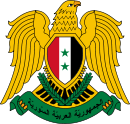
This article is part of the series:
Politics and government of
SyriaConstitutionExecutive- President
- Vice President
- Prime Minister
- Adel Safar
- Cabinet
LegislatureJudiciary- Court system
- High Judicial Council
- Supreme Constitutional Court
DivisionsElections- General elections
- Political parties
- National Progressive Front
- Ba'ath Party
- 2011 Syrian protests
Foreign policy
Main article: Politics of SyriaSyria is formally a republic. The Constitution of Syria was adopted 13 March 1971.[98] It defines Syria as a secular socialist state with Islam recognised as the majority religion.
Branches of government
The executive branch consists of the president, two vice presidents, the prime minister, and the Council of Ministers (cabinet). The constitution requires the president to be a Muslim[98] but does not make Islam the state religion.
The constitution gives the president the right to appoint ministers, to declare war and state of emergency, to issue laws (which, except in the case of emergency, require ratification by the People's Council), to declare amnesty, to amend the constitution, and to appoint civil servants and military personnel.[6] The president is approved by Syrian citizens in a referendum for a 7-year term.[98]
Syria's legislative branch is the unicameral People's Council. Syria does not hold multi-party elections for the legislature.[6] Two thirds of the seats are automatically allocated to the ruling coalition.[99]
Syria's judicial branches include the Supreme Constitutional Court, the High Judicial Council, the Court of Cassation, and the State Security Courts. Islamic jurisprudence is a main source of legislation and Syria's judicial system has elements of Ottoman, French, and Islamic laws. Syria has three levels of courts: courts of first instance, courts of appeals, and the constitutional court, the highest tribunal. Religious courts handle questions of personal and family law.[6] The Supreme State Security Court (SSSC) was abolished by President Bashar al-Assad by legislative decree No. 53 on 21 April 2011.[100]
Political parties
Article 8 of the Syrian constitution states that "the Arab Socialist Ba'ath Party leads the state and society." The President is the Secretary-General of the party, and the leader of the National Progressive Front governing coalition. The minor parties in the coalition are the Arab Socialist Movement, Arab Socialist Union, Communist Party of Syria (Unified), Communist Party of Syria (Bakdash), Social Democratic Unionists, Socialist Unionists, Syrian Social Nationalist Party, Democratic Socialist Unionist Party, Arabic Democratic Unionist Party, National Vow Movement. Outside of the coalition are 14 illegal Kurdish political parties.[101]
State control
Nearly all of Syria’s radio and television outlets are state owned, and the Baath Party controls nearly all newspapers.[102] The authorities operate several intelligence agencies[103] among them Shu'bat al-Mukhabarat al-'Askariyya, employing a large number of operatives.[104]
The Emergency Law, effectively suspending most constitutional protections, was in effect from 1963 until 21 April 2011.[100] It was justified by the government in the light of the continuing war with Israel over the Golan Heights.
Human rights
Main article: Human rights in SyriaSyria's human rights situation is among the worst in the world, according to human rights organizations such as Human Rights Watch.[105] Freedom House ranked Syria "Not Free" in its annual Freedom in the World survey.[106]
The authorities arrest democracy and human rights activists, censor websites, detain bloggers, and impose travel bans. Arbitrary detention, torture, and disappearances are widespread.[107] Although Syria's constitution guarantees gender equality, critics say that personal statutes laws and the penal code discriminate against women and girls. Moreover, it also grants leniency for so-called honor crimes.[107]
Administrative divisions
Main articles: Governorates of Syria and Districts of SyriaFurther information: List of cities in SyriaSyria is divided into fourteen governorates, or muhafazat (singular: muhafazah). The governorates are divided into a total of sixty-one districts, or manatiq (singular mintaqah), which are further divided into sub-districts, or nawahi (singular nahiya).
A governor, whose appointment is proposed by the minister of the interior, approved by the cabinet, and announced by executive decree, heads each governorate. The governor is assisted by an elected provincial council. Most of the Quneitra Governorate has been unilaterally annexed by Israel as the Golan Heights territory.
Damascus is the capital city of Syria. Latakia (population 554,000) along with Tartus are Syria's main ports on the Mediterranean sea. Other major cities include Aleppo (population 2,560,349) in northern Syria, Hama (population 696,863) in central Syria, Homs (population 1,033,000) in the south of Hama and Deir ez-Zor (population 230,000) on the Euphrates river in eastern Syria.
Military
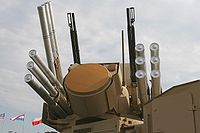 Pantsir-S1 Weapon System, containing an EHF phased-array tracking radar in the center, flanked by two twin-barrel 2A38M automatic anti-aircraft guns and 12 ready-to-launch missile-containers each containing one 57E6-E command guided surface to air missile.
Pantsir-S1 Weapon System, containing an EHF phased-array tracking radar in the center, flanked by two twin-barrel 2A38M automatic anti-aircraft guns and 12 ready-to-launch missile-containers each containing one 57E6-E command guided surface to air missile. Main article: Military of Syria
Main article: Military of SyriaThe President of Syria is commander in chief of the Syrian armed forces, comprising some 400,000 troops upon mobilization. The military is a conscripted force; males serve in the military upon reaching the age of 18.[108] The obligatory military service period is being decreased over time, in 2005 from two and a half years to two years, in 2008 to 21 months and in 2011 to year and a half.[109] About 20,000 Syrian soldiers were deployed in Lebanon until April 27, 2005, when the last of Syria's troops left the country after three decades.[108]
The breakup of the Soviet Union — long the principal source of training, material, and credit for the Syrian forces — may have slowed Syria's ability to acquire modern military equipment. It has an arsenal of surface-to-surface missiles. In the early 1990s, Scud-C missiles with a 500-kilometer range were procured from North Korea, and Scud-D, with a range of up to 700 kilometers, is allegedly being developed by Syria with the help of North Korea and Iran, according to Zisser.[110]
Syria received significant financial aid from Persian Gulf Arab states as a result of its participation in the Persian Gulf War, with a sizable portion of these funds earmarked for military spending.
Foreign relations
Main article: Foreign relations of SyriaTerritorial issues
Syrian-Turkish dispute over İskenderun (Hatay)
Main articles: Hatay State and Hatay ProvinceThere is a deep rooted disagreement between Turkey and Syria over Hatay Province.
At present Syrians hold the view that this land is historically Syrian and was illegally ceded in the late 1930s to Turkey by France – the mandatory occupying power of Syria (between 1920 and 1946). The Turks remember Syria as a former Ottoman vilayet with embitterment. In 1938, the Turkish Army went into the former Syrian Mediterranean province with French approval and expelled most of its Alawite Arab and Armenian inhabitants.[111] Before this, Alawi Arabs and Armenians were the majority of the provinces population.[111] For the referendum, Turkey crossed tens of thousands of Turks into Alexandretta to vote.[112]
In 1938, the province declared its independence from France and the following 29 June, the parliament of the newly declared Hatay Republic voted to join Turkey. This referendum has been labeled both "phoney" and "rigged", and that it was a way for the French to let Turks take over the area, hoping that they would turn on Hitler.[111][113] The Syrian government recognized this decision in 2004 and gave up on territorial claims. Syrians still consider this land as integral Syrian territory. Syrians call this land Liwaaa aliskenderuna rather than the Turkish name of Hatay.
Israeli occupation of the Golan Heights
Main article: Golan HeightsSee also: Six-Day War and Syrian towns and villages depopulated in the Arab-Israeli conflictThe Golan Heights is a strategic plateau and mountainous region in southwestern Syria and Israel. Two-thirds of the area is currently occupied by Israel. It comprises 1,850 square kilometres (714 sq mi) and includes mountains reaching an altitude of 2,880 metres (9,449 ft) above sea level.
The heights dominate the plains below. The Jordan River, Lake Tiberias and the Hula Valley border the region on the west. To the east is the Raqqad Valley and the south is Yarmok River and valley. The northern boundary of the region is the mountain Jabal al-Sheikh (Mount Hermon), one of the highest in Southwest Asia.
An agreement to establish a demilitarized zone between Israel and Syria was signed on 20 July 1949,[114] but border clashes continued. Israel captured the Golan Heights from Syria in the 1967 Six-Day War. Between 80,000 and 109,000 of the inhabitants fled, mostly Druze and Circassians.[115][116]
In 1973, Syria tried to regain control of the Golan Heights in a surprise attack on Yom Kippur, the holiest day of the Jewish year. Despite initial Syrian advances and heavy Israeli losses, the Golan Heights remained in Israeli hands after a successful Israeli counter attack.
Syria and Israel signed an armistice agreement in 1974, and a United Nations observer force was stationed there. Israel unilaterally annexed the Golan Heights in 1981, although the Syrian government continues to demand the return of this territory, possibly in the context of a peace treaty. In 1982, Druze in the Golan Heights started a strike against the annexation of the territory. The strike lasted for six months and as a result the Israeli army sealed off Druze villages, allowing only those who wished to work in Israel to leave.[117] Israel has given the Druze citizens in the Golan Heights an Israeli citizenship after the annexation of the Golan Heights.[118]
After the Six-Day War, a population of 20,000 Syrians remained in the Golan Heights, most of them Druze. Since 2005, Israel has allowed Druze apple farmers in the Golan to sell their produce to Syria. In 2006, the export total reached 8,000 tons of apples.[119] Syrian residents of the Golan are also permitted to study at universities in Syria, where they are entitled to free tuition, books and lodging.[120]
Economy
Main article: Economy of SyriaSyria is a middle-income country, with an economy based on agriculture, oil, industry, and tourism. However, Syria's economy faces serious problems and challenges and impediments to growth, including: a large and poorly performing public sector; declining rates of oil production; widening non-oil deficit; wide scale corruption; weak financial and capital markets; and high rates of unemployment tied to a high population growth rate.[18]
As a result of an inefficient and corrupt centrally planned economy, Syria has low rates of investment, and low levels of industrial and agricultural productivity. Its GDP growth rate was approximately 5% in 2009, according to CIA World Factbook statistics. The two main pillars of the Syrian economy have been agriculture and oil. Agriculture, for instance, accounts for 17.7% of GDP and employs 17% of the total labor force. The government hopes to attract new investment in the tourism, natural gas, and service sectors to diversify its economy and reduce its dependence on oil and agriculture. The government has begun to institute economic reforms aimed at liberalizing most markets, but reform thus far has been slow and ad hoc. For ideological reasons, privatization of government enterprises is explicitly rejected. Therefore major sectors of the economy including refining, ports operation, air transportation, power generation, and water distribution, remain firmly controlled by the government.[18]
Syria has produced heavy-grade oil from fields located in the northeast since the late 1960s. In the early 1980s, light-grade, low-sulphur oil was discovered near Deir ez-Zor in eastern Syria. Syria's rate of oil production has been decreasing steadily, from a peak close to 600,000 barrels per day (95,000 m3/d) (bpd) in 1995 down to approximately 425,000 bbl/d (67,600 m3/d) in 2005. Experts generally agree that Syria will become a net importer of petroleum not later than 2012. Syria exported roughly 200,000 bbl/d (32,000 m3/d) in 2005, and oil still accounts for a majority of the country's export income. Syria also produces 22 million cubic meters of gas per day, with estimated reserves around 8.5 trillion cubic feet (240 km3). While the government has begun to work with international energy companies in the hopes of eventually becoming a gas exporter, all gas currently produced is consumed domestically.[18]
Some basic commodities, such as diesel, continue to be heavily subsidized, and social services are provided for nominal charges. The subsidies are becoming harder to sustain as the gap between consumption and production continues to increase. Syria has a population of approximately 22.2 million people, and Syrian Government figures place the population growth rate at 2.45%, with 75% of the population under the age of 35 and more than 40% under the age of 15.
Approximately 200,000 people enter the labor market every year. According to Syrian Government statistics. Government and public sector employees constitute over one quarter of the total labor force. Government officials acknowledge that the economy is not growing at a pace sufficient to create enough new jobs annually to match population growth. The UNDP announced in 2005 that 30% of the Syrian population lives in poverty and 11.4% live below the subsistence level.[18]
Foreign trade
Given the policies adopted from the 1960s through the late 1980s, which included nationalization of companies and private assets, Syria failed to join an increasingly interconnected global economy. Syria withdrew from the General Agreement on Tariffs and Trade (GATT) in 1951 because of Israel's accession. It is not a member of the World Trade Organization (WTO), although it submitted a request to begin the accession process in 2001. Syria is developing regional free trade agreements. As of 1 January 2005, the Greater Arab Free Trade Area (GAFTA) came into effect and customs duties were eliminated between Syria and all other members of GAFTA.
In addition, Syria has signed a free trade agreement with Turkey, which came into force in January 2007, and initialed an Association Agreement with the European Union, which has yet to be signed. Although Syria claims a recent boom in non-oil exports, its trade numbers are notoriously inaccurate and out-of-date. Syria's main exports include crude oil, refined products, raw cotton, clothing, fruits, and grains. The bulk of Syrian imports are raw materials essential for industry, vehicles, agricultural equipment, and heavy machinery. Earnings from oil exports as well as remittances from Syrian workers are the government's most important sources of foreign exchange.[18]
Transport
Main article: Transport in SyriaSyria has three international airports (Damascus, Aleppo and Lattakia), which serve as hubs for Syrian Air and are also served by a variety of foreign carriers.[121]
The majority of Syrian cargo is carried by Chemins de Fer Syriens (the Syrian railway company), which links up with Turkish State Railways (the Turkish counterpart). For a relatively under developed country Syria's railway infrastructure is of a high quality with many high speed services.[122]
Demographics
Population in Syria[123] Year Million 1971 6.6 1990 12.7 2009 21.1 Source: OECD/World Bank Main article: Demographics of SyriaMost people live in the Euphrates River valley and along the coastal plain, a fertile strip between the coastal mountains and the desert. Overall population density in Syria is about 99 per km² (258 per square mile). According to the World Refugee Survey 2008, published by the U.S. Committee for Refugees and Immigrants, Syria hosted a population of refugees and asylum seekers number approximately 1,852,300. The vast majority of this population was from Iraq (1,300,000), but sizeable populations from the former British Mandate of Palestine (543,400) and Somalia (5,200) also lived in the country.[124]
Education is free and compulsory from ages 6 to 12. Schooling consists of 6 years of primary education followed by a 3-year general or vocational training period and a 3-year academic or vocational program. The second 3-year period of academic training is required for university admission. Total enrollment at post-secondary schools is over 150,000. The literacy rate of Syrians aged 15 and older is 90.7% for males and 82.2% for females.[125][126]
Ethnic groups
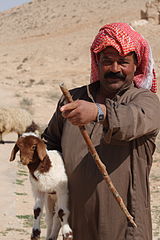 Syrian Bedouin shepherd
Syrian Bedouin shepherd
Syrians are an overall indigenous Levantine people, closely related to their immediate neighbours, like Lebanese people, Palestinians, and Jordanians.[127][128]
Syrian Arabs, together with some 400,000 UNRWA Palestinian Arabs make up over 90% of the population.[129]
Druze number around 500,000, and concentrate mainly in the southern area of Jabal al-Druze.[130]
Syria also hosts non-Arab ethnic minorities. The largest of these groups, Kurds, constitutes about 10% of the population, or approximately 2 million people.[131] Most Kurds reside in the northeastern corner of Syria and most speak the Kurmanji variant of the Kurdish language.
The majority of Syrian Turkmen live in Aleppo, Damascus and Latakia and number around 750,000–1,500,000.[132]
The Assyrians/Syriacs are significant ethnic Christian minorities that mainly live in the north and northeast (al-Qamishli, al-Hasakah) and number around 877,000–1,200,000 in Syria. Assyrian people in particular retain Syriac, an Aramaic dialect, as a spoken language.[133] Although their numbers have been boosted by many Iraqi refugees since the Iraq War.[134]
Armenians number approximately 190,000. Syria holds the 7th largest Armenian population in the world. In addition, approximately 1,300,000 Iraqi refugees were estimated to live in Syria in 2007. Roughly 50 percent of these refugees were Sunni Arab Muslims, 24 percent Shi'a Arab Muslim, and 20 percent Assyrian Christian.[124] During the Mandate years, there was a significant French population, many of whom left Syria after the end of French rule. As of 1987, approximately 100,000 Circassians lived in Syria.[135]
The Americas have long been a destination for Christian Arab migration, with Syrians arriving in some countries at least as early as the 19th century. The largest concentration of Syrians outside the Arab world is in Brazil, which has millions of people of Arab ancestry.[136] The majority of Arab Argentines are from either Lebanese or Syrian background.[137]
Religion
Main article: Religion in SyriaMuslim 87% (Sunnis account for 74% of the population,[138] while the remaining 13% are Shia – Alawite, Twelvers, and Ismailis combined),[138] Druze 3%,[138] Christian 10%[138] (majority Antiochian Orthodox, other Christian include Greek Catholic, Assyrian Church of the East, Armenian Orthodox, Protestants and other various denominations).
President Bashir Al-Assad's family is Alawite and Alawites dominate the government of Syria and hold key military positions.[139]
Christians, a sizable number (2.5 million) of which are also found among Syrian Palestinians, are divided into several groups. Chalcedonian Antiochian Orthodox ("Greek Orthodox"; Arabic: الروم الارثوذكس, ar-Rūmu 'l-Urṯūḏuks) make up 45% of the Christian population; the Catholics (Melkite, Armenian Catholic, Syriac Catholic, Maronite, Chaldean Catholic and Latin) make up 16%; the Syriac Orthodox Church 27%, the Armenian Apostolic Church 8%, Assyrian Church of the East and several smaller Christian denominations account the remainder. Many Christian monasteries also exist. Many Christian Syrians belong to a high socio-economic class.[140]
Languages
Arabic is the official language and Syrian Arabic is most widely spoken. Kurdish (in its Kurmanji form) is widely spoken in the Kurdish regions of Syria. Many educated Syrians also speak English and French. Armenian and Turkish (South Azeri dialect) are spoken among the Armenian and Turkmen minorities. Before the advent of Arabic, Aramaic was the lingua franca of the region and is still spoken among Arameans and Assyrians. Syriac is used as the liturgical language of various Syriac denominations. Most remarkably, Western Neo-Aramaic is still spoken in the village of Ma`loula, and two neighbouring villages, 35 miles (56 km) northeast of Damascus.
Education
Main article: Education in SyriaThe strong educational system in Syria is based on the old French system. Education is free in all public schools and obligatory up to the 9th grade. Schools are divided into three levels:
- 1st to 4th grade: Basic Education Level I (Arabic: التعليم الأساسي: حلقة أولى)
- 5th to 9th grade: Basic Education Level II (Arabic: التعليم الأساسي: حلقة ثانية)
- 10th to 12th grade: Secondary Education (Arabic: التعليم الثانوي), the equivalent of high school.
Final exams of the 9th grade are carried out nationally at the same time. The result of these exams determines if the student goes to the "general" secondary schools or the technical secondary schools. Technical secondary schools include industrial and agricultural schools for male students, crafts school for female students, and commercial and computer science schools for both.
At the beginning of the 11th grade, those who go to "general" secondary school have to choose to continue their study in either the "literary branch" or the "scientific branch".
The final exams of the 12th grade (the baccalaureate) are also carried out nationally and at the same time. The result of these exams determines the university, college and specialization that the student attends. To do that the student has to apply through a complicated system called Mufadalah.
Colleges charge modest fees ($10–20 a year) if the student achieves the sufficient marks in his Baccalaureate exams. If not, the student may opt to pay higher fees ($1500–4000) to enroll. There are some private schools and colleges but their fees are much higher.
Most universities in Syria follow the French model of higher education, the university stages and the academic degrees are:
- First stage: the Licence awarded after 4 years to 6 years depending on the field.
- Second stage: the DEA or DESS 1–2 years postgraduate degree equivalent to the Master's degree in the American/English systems.
- Third stage: the doctorat 3–5 years after the DEA or an equivalent degree.
Since 1967, all schools, colleges, and universities have been under close government supervision by the Baath Party.[141]
There are 5 state universities in Syria, and 11 private universities.[142] The top two are University of Damascus (180,000 students),[143] and University of Aleppo.[144] One school is a joint Syrian-European program; the Higher Institute of Business Administration (HIBA) offer undergraduate and gradudate degrees.[145]
Culture
See also: Public holidays in SyriaThe scribes of the city of Ugarit (modern Ras Shamra) created a cuneiform alphabet in the 14th century BCE. The alphabet was written in the familiar order we use today.[146]
Archaeologists have discovered extensive writings and evidence of a culture rivaling those of Iraq, and Egypt in and around the ancient city of Ebla (modern Tell Mardikh).[147] Later Syrian scholars and artists contributed to Hellenistic and Roman thought and culture. Cicero was a pupil of Antiochus of Ascalon[148] at Athens; and the writings of Posidonius of Apamea[149] influenced Livy and Plutarch.
Philip Hitti claimed, "the scholars consider Syria as the teacher for the human characteristics", and Andrea Parrot the French archaeologist and main discoverer and excavator of the Mari State writes, "each civilized person in the world should admit that he has two home countries: the one he was born in, and Syria."
Syria is a traditional society with a long cultural history.[150] Importance is placed on family, religion, education and self discipline and respect. The Syrian's taste for the traditional arts is expressed in dances such as the al-Samah, the Dabkeh in all their variations and the sword dance. Marriage ceremonies and the birth of children are occasions for the lively demonstration of folk customs.[151]
Traditional Houses of the Old Cities in Damascus, Aleppo and the other Syrian cities are preserved and traditionally the living quarters are arranged around one or more courtyards, typically with a fountain in the middle supplied by spring water, and decorated with citrus trees, grape vines, and flowers.[151]
Outside of larger city areas such as Damascus, Aleppo or Homs, residential areas are often clustered in smaller villages. The buildings themselves are often quite old (perhaps a few hundred years old), passed down to family members over several generations. Residential construction of rough concrete and blockwork is usually unpainted, and the palette of a Syrian village is therefore simple tones of grays and browns.[152]
Syrians have contributed to Arabic literature and music and have a proud tradition of oral and written poetry. Syrian writers, many of whom immigrated to Egypt, played a crucial role in the nahda or Arab literary and cultural revival of the 19th century. Prominent contemporary Syrian writers include, among others, Adonis, Muhammad Maghout, Haidar Haidar, Ghada al-Samman, Nizar Qabbani and Zakariyya Tamer.
There was a private sector presence in the Syrian cinema industry until the end of the 1970s, but private investment has since preferred the more lucrative television serial business. Syrian soap operas, in a variety of styles (all melodramatic, however), have considerable market penetration throughout the eastern Arab world.[153]
Although declining, Syria's handicraft industry still employs thousands.
Syrian cuisine
Main article: Syrian cuisineFattoush, an example of Syrian cuisine
The Syrian cuisine is rich and varied in its ingredients and is linked to the region of Syria where a specific dish has originated. Syrian food mostly consists of Southern Mediterranean, Greek, and Southwest Asian dishes. Some Syrian dishes also evolved from Turkish and French cooking. Dishes like shish kebab, stuffed zucchini, yabra' (stuffed grape leaves, the word yapra' derıves from the Turkish word 'yaprak' meaning leaf).
The main dishes that form Syrian cuisine are kibbeh, hummus, tabbouleh, fattoush, labneh, shawarma, mujaddara, shanklish, pastırma, sujuk and ba'lawa. Ba'lawa is made of filo pastry filled with chopped nuts and soaked in honey. Syrians often serve selections of appetizers, known as meze, before the main course. za'atar, minced beef, and cheese manakish are popular hors d'œuvres. The Arabic flatbread khubz is always eaten together with meze.
Syrians are also well-known for their cheese. The very popular string cheese jibbneh mashallale is made of curd cheese and is pulled and twisted together. Syrians also make cookies to usually accompany their cheese called ka'ak. These are made of farina and other ingredients, rolled out, shaped into rings and baked. Another form of a similar cookie is to fill with crushed dates mixed with butter to accompany their jibbneh mashallale.
Drinks in Syria vary depending on the time of the day and the occasion. Arabic coffee, also known as Turkish coffee is the most well-known hot drink usually prepared in the morning at breakfast or in the evening. it is usually served for guests or after food. Arak, an alcoholic drink, is also a well-known beverage served mostly on special occasions. More examples of Syrian beverages include Ayran, Jallab, White coffee, and a locally manufactured beer called Al Shark.[154]
Sport in Syria
See also: Rugby union in SyriaPopular Sports include: Football, Basketball, Swimming, and Tennis. Syria is home to Al- Fayhaa Sports complex in the capital, Damascus , and the 5th and 7th Pan Arab Games were held in the Al- Fayhaa Sports stadium. Syria is also home to many Football clubs, like for example, Al-Jaish, Al-Wahda, and Al Majd in Damascus, and Al-Horriya, Al-Ittihad of Aleppo, Jalaa Club, and Ourubeh Club, in Aleppo ,and Al-Karamah in Homs.
The Aleppo International Stadium is home to the Syrian national football team, which the team has enjoyed some success, and the team has been to 4 Asian Cups. The team's first international was against Turkey on November 20, 1949, and lost against Turkey 7–0. The team is currently ranked 94th in the world by FIFA World Rankings. Syria also has a Professional Football League for Syrian Football clubs, and teams, like teams from Damascus, Aleppo, Homs and other cities are playing in the 2009–2010 season.
Music of Syria
Main article: Music of Syria Amal al-Atrash was born in Aleppo and immigrated to Egypt. She was the only female voice in Arab music to rival that of Umm Kulthum[155]
Amal al-Atrash was born in Aleppo and immigrated to Egypt. She was the only female voice in Arab music to rival that of Umm Kulthum[155]
Syria's capital, Damascus, has long been one of the Arab world's centers for cultural and artistic innovation, especially in the field of classical Arab music. Syria has also produced several pan-Arab stars, including Asmahan, Farid al-Atrash and singer Lena Chamamyan. The city of Aleppo is known for its muwashshah, a form of Andalous sung poetry popularized by Sabri Moudallal, as well as popular stars like Sabah Fakhri.
Also, Syria was one of the earliest centers of Christian hymnody, in a repertory known as Syrian chant, which continues to be the liturgical music of some of the various Syrian Christians.
There was formerly a distinctive tradition of Syrian Jewish religious music, which still flourishes in the Syrian-Jewish community of New York: see The Weekly Maqam, Baqashot and Pizmonim.
Syrian literature
Main article: Literature of SyriaSyrian literature has been influenced by the literatures of other Arab countries, by French literature, and by the country's political history.
From early times to 1948
Under Ottoman rule, literary production was subjected to censorship. In the second half of the 19th century and the early 20th, aspiring Syrian writers often chose emigration, moving primarily to Egypt--where they contributed to al-Nahda, the renaissance of Arabic literature--and to the United States, developing Syrian literature from abroad.
From 1918 to 1926, while Syria was under French rule, French Romantic influences inspired Syrian authors, many of whom turned away from the traditional models of Arabic poetry.
From 1948 to the present day
In 1948, the partitioning of neighbouring Palestine and the establishment of Israel brought about a new turning point in Syrian writing. Adab al-Iltizam, the "literature of political commitment", deeply marked by social realism, mostly replaced the romantic trend of the previous decades. Hanna Mina, rejecting art for art's sake and confronting the social and political issues of his time, was arguably the most prominent Syrian novellist of this era. Following the Six-Day War in 1967, Adab al-Naksa, the "literature of defeat", grappled with the causes of the Arab defeat.
Baath Party rule, since the 1966 coup, has brought about renewed censorship. As Hanadi Al-Samman puts it,
In the face of threats of persecution or imprisonment, most of Syria's writers had to make a choice between living a life of artistic freedom in exile-as do Nizar Kabbani, Ghada al-Samman, Hamida Na'na', Salim Barakat, and prominent poet, critic, and novelist 'Ali Ahmad Sa'id (Adonis)-or resorting to subversive modes of expression that seemingly comply with the demands of the authoritarian police state while undermining and questioning the legitimacy of its rule through subtle literary techniques and new genres.
In this context, the genre of the historical novel, spearheaded by Nabil Sulayman, Fawwaz Haddad, Khyri al-Dhahabi and Nihad Siris, is sometimes used as a means of expressing dissent, critiquing the present through a depiction of the past. Syrian folk narrative, as a subgenre of historical fiction, is imbued with magical realism, and is also used as a means of veiled criticism of the present. Salim Barakat, a Syrian émigré living in Sweden, is one of the leading figures of the genre.
Contemporary Syrian literature also encompasses science fiction and futuristic utopiae (Nuhad Sharif, Talib Umran), which may also serve as media of dissent.
Mohja Kahf has argued that literary dissent is typically expressed through the "poetics of Syrian silence":
The nostalgic, moist-eyed silences of Ulfat Idilbi's narrative could not be more different from the chilling, cynical silences in Zakaria Tamer's stories. The impassioned lacunae in Nizar Kabbani's proclaim exactly what it is they are not saying explicitly, while the poet Muhammad al-Maghut's silence is sardonic, sneering both at the authorities and at himself, at the futility and absurdity of the human situation under authoritarian rule.
Fairs and festivals
Festival/Fair City Month Spring Festival of Hama Hama April Flower Festival Latakia April Assyrian New Year Festival Qamishli April Nowruz Persian New Year Festival Qamishli 21 March Traditional Festival Palmyra May International Flower Fair Damascus May Syrian Song Festival Aleppo July Marmarita Festival Homs August Festival of le Crac des Chevaliers and the Valley for Arts&Culture
Homs August Vine Festival As Suwayda September Cotton Festival Aleppo September Damascus International Fair Damascus September Festival of Love and Peace Lattakia 2–12 August Bosra Festival Bosra September Film and Theatre Festival Damascus November Cultural Festival of Jableh Jableh July Jasmine Festival Damascus April See also
- Outline of Syria
- Index of Syria-related articles
- Corruption Perceptions Index
References
- Boczek, Boleslaw Adam (2006). International Law: A Dictionary. Scarecrow Press. ISBN 0-8108-5078-8
- Finkelstein, Norman (2003). Image and reality of the Israel-Palestine conflict. Verso. ISBN 1859844421. http://books.google.com/books?id=vNb5VkyxDlYC&printsec=frontcover&dq=Image+and+reality+of+the+Israel-Palestine+conflict&hl=en&ei=o40cTd7pIJHoOfzYgKUJ&sa=X&oi=book_result&ct=result&resnum=1&ved=0CCcQ6AEwAA#v=onepage&q&f=false.
- Glass, Charles. "Tribes with Flags: A Dangerous Passage Through the Chaos of the Middle East", Atlantic Monthly Press (New York) and Picador (London), 1990 ISBN 0-436-18130-4
- Karoubi, Mohammad Taghi (2004). Just or Unjust War? Ashgate Publishing ISBN 0-7546-2375-0
- The editors of Time-Life Books. (1989). Timeframe AD 1200–1300: The Mongol Conquests. Time-Life Books. ISBN 0-8094-6437-3.
- Forward Magazine ([1]), Syria's English monthly since 2007.
Footnotes
- ^ "Central Intelligence Agency. November 2 2011 est". Cia.gov. https://www.cia.gov/library/publications/the-world-factbook/geos/sy.html. Retrieved 2011-04-23.
- ^ a b c d "Syria". International Monetary Fund. http://www.imf.org/external/pubs/ft/weo/2010/01/weodata/weorept.aspx?sy=2007&ey=2010&scsm=1&ssd=1&sort=country&ds=.&br=1&c=463&s=NGDPD%2CNGDPDPC%2CPPPGDP%2CPPPPC%2CLP&grp=0&a=&pr.x=58&pr.y=20. Retrieved 2010-04-21.
- ^ "Human Development Report 2010". United Nations. 2010. http://hdr.undp.org/en/media/HDR_2010_EN_Table1.pdf. Retrieved 5 November 2010.
- ^ "World Directory of Minorities: Syria Overview". Minority Rights Group International. http://www.minorityrights.org/?lid=5266&tmpl=printpage. Retrieved 2010-09-11.
- ^ Neolithic Tell Ramad in the Damascus Basin of Syria. Retrieved 2010-02-01.
- ^ a b c d "Syria (05/07)". State.gov. http://www.state.gov/r/pa/ei/bgn/3580.htm. Retrieved 2008-10-25.
- ^ Freedom on the world report. Retrieved 2010-02-01.
- ^ a b Michael Bröning (2011-03-07). "The Sturdy House That Assad Built". The Foreign Affairs. http://www.foreignaffairs.com/articles/67561/michael-broening/the-sturdy-house-that-assad-built.
- ^ "Libya NTC Recognises Syrian National Council, Closes Syrian Embassy". Naharnet. 10 October 2011. http://www.naharnet.com/stories/en/17161-libya-ntc-recognises-syrian-national-council-closes-syrian-embassy. Retrieved 15 October 2011.
- ^ Herodotus, The Histories, VII.63, s:History of Herodotus/Book 7.
- ^ Joseph, John (2008). "Assyria and Syria: Synonyms?" (PDF). http://www.jaas.org/edocs/v11n2/JohnJoseph.pdf.
- ^ First proposed by Theodor Nöldeke in 1881; cf. Harper, Douglas (November 2001). "Syria". Online Etymology Dictionary. http://www.etymonline.com/index.php?term=Syria. Retrieved 2007-06-13.
- ^ Greater Syria: The History of an Ambition. Middle East Forum. 1992. p. 13. ISBN 0195060229. http://books.google.com/?id=J3PsAb1uV94C&printsec=frontcover#PPA13,M1. Retrieved 2010-02-01.
- ^ Pliny (AD 77). "Book 5 Section 66". Natural History. University of Chicago Website. ISBN 8424919017. http://penelope.uchicago.edu/Thayer/L/Roman/Texts/Pliny_the_Elder/5*.html.
- ^ "Syria :: Roman provincial organization – Britannica Online Encyclopedia". Britannica.com. http://www.britannica.com/EBchecked/topic/578856/Syria/29905/Roman-provincial-organization#default. Retrieved 2008-10-25.
- ^ a b National Council of Geography Teachers (U.S.) (1928). The Journal of Geography. The Journal of geography. p. 167.
- ^ F. A. Schaeffer, Claude (2003). Syria and the Cradle of Civilization: The Findings of Claude F a Schaeffer in Ras Shamra. Trubner & Company. ISBN 1844531295.
- ^ a b c d e f g h i j k l "Background Note: Syria". United States Department of State, Bureau of Near Eastern Affairs, May 2007. http://www.state.gov/r/pa/ei/bgn/3580.htm.
- ^ a b c d "Syria: A country Study – Ancient Syria". Library of Congress. Data as of April 1987. http://ancienthistory.about.com/library/bl/bl_syriaancient.htm. Retrieved 2007-09-05.
- ^ "The Aramaic Language and Its Classification". Journal of Assyrian Academic Studies 14 (1). http://www.jaas.org/edocs/v14n1/e8.pdf.
- ^ Relations between God and Man in the Hurro-Hittite Song of Release, Mary R. Bachvarova, Journal of the American Oriental Society, Jan–Mar SAAD 2005
- ^ a b Cavendish Corporation, Marshall (2006). World and Its Peoples. Marshall Cavendish. p. 183. ISBN 0761475710.
- ^ Syria: History Encyclopædia Britannica. 2008. Encyclopædia Britannica Online. 2008-10-22.
- ^ Timeframe pp. 59–75.
- ^ Battle of Aleppo.
- ^ "The Eastern Mediterranean, 1400–1600 A.D". Metmuseum.org. http://www.metmuseum.org/toah/ht/08/wae/ht08wae.htm. Retrieved 2011-04-23.
- ^ "Syria – Ottoman Empire". Library of Congress Country Studies.
- ^ Mandat Syrie-Liban. Retrieved 2010-02-01.
- ^ Peter N. Stearns, William Leonard Langer (2001). "The Middle East, p. 761". The Encyclopedia of World History. Houghton Mifflin Books. ISBN 9780395652374. http://books.google.com/?id=MziRd4ddZz4C&dq=league+of+nations+mandate+for+syria.
- ^ a b c d e f g h i j k l m "Syria: World War II and independence". Britannica Online Encyclopedia. http://www.britannica.com/EBchecked/topic/578856/Syria/29922/World-War-II-and-independence.
- ^ Walt, Stephen (1990). The Origins of Alliances. Cornell University Press. pp. 72–73. ISBN 0801494184.
- ^ Brecher, Michael; Jonathan Wilkenfeld (1997). A Study of Crisis. University of Michigan Press. pp. 345–346. ISBN 0472108069.
- ^ Martin Gilbert (2002). The Routledge atlas of the Arab-Israeli conflict. Psychology Press. p. 66. ISBN 9780415281164. http://books.google.com/books?id=UNvJ1FOwiAwC&pg=PA66. Retrieved 21 March 2011.
- ^ Oren, Michael. (2006). "The Six-Day War", in Bar-On, Mordechai (ed.), Never-Ending Conflict: Israeli Military History. Greenwood Publishing Group. ISBN 0-275-98158-4, page 135
- ^ Gilbert, Martin. (2008). Israel – A History. McNally & Loftin Publishers. ISBN 0688123635, page 365
- ^ "United Nations Yearbook, 1966". http://unispal.un.org/unispal.nsf/9a798adbf322aff38525617b006d88d7/f46f0d5ca57118da852562cf006c1096?OpenDocument&Highlight=0,united,nations,yearbook,1966.
- ^ Alasdair Drysdale, Raymond A. Hinnebusch (1991), "Syria and the Middle East peace process", Council on Foreign Relations, ISBN 0876091052, page 99
- ^ "OpenDocument Yearbook of the United Nations 1967". http://domino.un.org/UNISPAl.NSF/0/17bdf357679b218f85256c41006ad66d?.
- ^ Mark A. Tessler (1994). A History of the Israeli-Palestinian conflict. Indiana University Press. p. 382. ISBN 9780253208736. http://books.google.com/books?id=3kbU4BIAcrQC&pg=PA382. Retrieved 29 December 2010.
- ^ General's Words Shed a New Light on the Golan By Serge Schmemann, May 11, 1997. Retrieved 2010-02-01.
- ^ Eyal Zisser (2002). "June 1967: Israel’s Capture of the Golan Heights". Israel Studies 7 (1): 168–194.
- ^ "A Campaign for the Books". Time Magazine. September 1, 1967. http://www.time.com/time/printout/0,8816,837237,00.[dead link]
- ^ "Jordan asked Nixon to attack Syria, declassified papers show - CNN.com". Edition.cnn.com. 2007-11-28. http://edition.cnn.com/2007/POLITICS/11/28/nixon.papers/index.html. Retrieved 2008-10-25.
- ^ Seale, Patrick (1988). Asad: The Struggle for the Middle East. University of California Press. ISBN 0520069765.
- ^ Rabinovich, Abraham (2005). The Yom Kippur War: The Epic Encounter That Transformed the Middle East. New York, New York: Schocken Books. p. 302. ISBN 0805241760.
- ^ Anti Syrian leader warns of more Lebanon killings The Epoch Times, 22 November 2006
- ^ "Security Council Press Release SC/8372". Un.org. 2005-04-29. http://www.un.org/News/Press/docs/2005/sc8372.doc.htm. Retrieved 2011-04-23.
- ^ Syrian intelligence still in Lebanon Washington Post, April 27, 2005
- ^ "Syria's Role in Lebanon by Mona Yacoubian: USIPeace Briefing: U.S. Institute of Peace". Usip.org. Archived from the original on 2008-07-18. http://web.archive.org/web/20080718063946/http://www.usip.org/pubs/usipeace_briefings/2006/1109_syria_lebanon.html. Retrieved 2008-10-25.
- ^ "تقرير الوزير اللبناني أحمد فتفت عن ملف المجنسين". Alzaytouna.net. http://www.alzaytouna.net/arabic/?c=201&a=52460. Retrieved 2008-10-25.
- ^ Ghadry, Farid N. (Winter 2005). "Syrian Reform: What Lies Beneath". The Middle East Quarterly. http://www.meforum.org/683/syrian-reform-what-lies-beneath.
- ^ Wright, Robin, Dreams and Shadows : the Future of the Middle East, Penguin Press, 2008, p.243-4
- ^ Marc Perelman (July 11, 2003). "Syria Makes Overture Over Negotiations - Forward.com". Forward.com. http://www.forward.com/articles/7655/. Retrieved 2008-10-25.
- ^ "Syria Smothering Freedom of Expression: the detention of peaceful critics". Amnesty International. http://www.amnesty.org/en/library/asset/MDE24/007/2002/en/ee9fa6f2-d870-11dd-9df8-936c90684588/mde240072002en.html. Retrieved 5 July 2011.
- ^ George, Alan (2003). Syria : neither bread nor freedom. London: Zed Books. pp. 56–58. ISBN 1842772139. http://books.google.com/books?id=dFdbVVcKsSIC&printsec=frontcover&dq=Alan+George,+Syria:+Neither+Bread+nor+Freedom&hl=en&src=bmrr&ei=IDYTTojlFYaRswbp56CKDw&sa=X&oi=book_result&ct=book-preview-link&resnum=1&sqi=2&ved=0CDIQuwUwAA#v=onepage&q&f=false.
- ^ "The Damascus Declaration for Democratic National Change". 15 October 2005. http://www.demdigest.net/damascusdeclaration.html. Retrieved 5 July 2011.
- ^ Ghadry, Farid N. (Winter 2005). "Syrian Reform: What Lies Beneath". The Middle East Quarterly. http://www.meforum.org/683/syrian-reform-what-lies-beneath.
- ^ "Profile: Syria's Bashar al-Assad". BBC News. Last Updated:. http://news.bbc.co.uk/2/hi/middle_east/2579331.stm. Retrieved 2008-10-25.
- ^ "Bashar Al-Assad , President, Syria". Reporters Without Borders. http://en.rsf.org/predator-bashar-al-assad,37213.html.
- ^ "Red lines that cannot be crossed – The authorities don’t want you to read or see too much". The Economist. 2008-07-24. http://www.economist.com/node/11792330.
- ^ Huggler, Justin (2003-10-06). "Israel launches strikes on Syria in retaliation for bomb attack". London: The Independent. http://www.independent.co.uk/news/world/middle-east/israel-launches-strikes-on-syria-in-retaliation-for-bomb-attack-582373.html. Retrieved 2008-10-23.
- ^ Fact Sheet, The White House.
- ^ "Naharnet Newsdesk – Syria Curbs Kurdish Riots for a Merger with Iraq's Kurdistan". Naharnet.com. http://www.naharnet.com/domino/tn/Newsdesk.nsf/Story/8A24116B9C5C2F34C2256E59002D08F0?OpenDocument&PRINT. Retrieved 2008-10-25.
- ^ Guerin, Orla (March 6, 2005). "Syria sidesteps Lebanon demands". BBC News. http://news.bbc.co.uk/2/hi/middle_east/4322477.stm. Retrieved April 28, 2010.
- ^ Sanger, David (2007-10-14). "Israel Struck Syrian Nuclear Project, Analysts Say". The New York Times. http://www.nytimes.com/2007/10/14/washington/14weapons.html?hp. Retrieved 2007-10-15.
- ^ Walker, Peter; News Agencies (21 May 2008). "Olmert confirms peace talks with Syria". London: The Guardian. http://www.guardian.co.uk/world/2008/may/21/israelandthepalestinians.syria. Retrieved 2008-05-21. "Israel and Syria are holding indirect peace talks, with Turkey acting as a mediator...."
- ^ Q&A: Syrian activist Suhair Atassi. Al Jazeera English. 2011-02-09. http://english.aljazeera.net/indepth/2011/02/201129135657367367.html. Retrieved 2011-02-13.
- ^ "'Day of rage' protest urged in Syria - World news - Mideast/N. Africa - msnbc.com". MSNBC. http://www.msnbc.msn.com/id/41400687/ns/world_news-mideastn_africa/. Retrieved 2011-02-03.
- ^ ""Day of Rage" planned for Syria; protests scheduled for Feb 4–5 – aysor.am – Hot news from Armenia". aysor.am. http://www.aysor.am/en/news/2011/02/03/syrian-facebook-twitter/. Retrieved 2011-02-03.
- ^ theepochtimes.com. "Fresh Protests Erupt in Syria". http://www.theepochtimes.com/n2/content/view/53074/. Retrieved 15 March 2011.
- ^ Youtube/Al Arabiya. "السوريون يكسرون جدار الخوف بالتظاهر في قلب دمشق". http://www.youtube.com/watch?v=rRHRxUxRbxo. Retrieved 15 March 2011.
- ^ Al Arabiya. "ردّدوا هتافات تدعو لمحاربة الفساد وفتح باب الحريات". http://www.alarabiya.net/articles/2011/03/15/141661.html. Retrieved 15 March 2011.
- ^ sawtbeirut.com. "الاف السوريين يثورون في قلب دمشق و المحافظات مطالبين بالحرية". http://www.sawtbeirut.com/news-in-arabic/world-now/16474-syria-revolution-2011-march-15.html. Retrieved 16 March 2011.
- ^ Youtube/Al Jazeera. "آخر اخبار انتفاضة سورية من فضائية الجزيرة". http://www.youtube.com/watch?v=sMNBN1PhjzY. Retrieved 15 March 2011.
- ^ Youtube/BBC. "تقرير قناه ال BBC للانتفاضه السوريه". http://www.youtube.com/watch?v=iAUOqfRSEaM. Retrieved 15 March 2011.
- ^ Youtube. "مظاهرة أمام السفارة السورية اليوم بالتزامن مع إنطلاق الثورة السورية". http://www.youtube.com/watch?v=oCA4iSugabU. Retrieved 16 March 2011.
- ^ BBC. "مظاهرة احتجاج في دمشق تطالب بالحريات". http://www.bbc.co.uk/arabic/middleeast/2011/03/110315_syria_protest.shtml. Retrieved 15 March 2011.
- ^ sawtbeirut.com. "معلومات عن سقوط شهداء في تظاهرات الثلاثاء في سوريا". http://sawtbeirut.com/news-in-arabic/world-now/16483-2011-03-16-18-33-05.html. Retrieved 16 March 2011.
- ^ voanews.com. "Syrian Security Forces Break Up Damascus Protest". http://www.voanews.com/english/news/middle-east/Syrian-Security-Forces-Break-Up-Damascus-Protest-118085199.html. Retrieved 16 March 2011.
- ^ Al Jazeera. "Rare public protest quashed in Syria". http://english.aljazeera.net/news/middleeast/2011/03/2011316131236735771.html. Retrieved 16 March 2011.
- ^ AFP. "Syrian security forces disperse Damascus demo". http://www.google.com/hostednews/afp/article/ALeqM5hN_8F5MkEvOPFuMqr-9HStxVy3iw?docId=CNG.e314ba0dc0a9061349e6fe1072be714a.5f1. Retrieved 16 March 2011.
- ^ Youtube. "مظاهرة أمام القنصلية السورية في اسطنبول". http://www.youtube.com/watch?v=CyXg8Hm8Hjs. Retrieved 16 March 2011.
- ^ Youtube/Al Arabiya. "أسماء الناشطين المعتقلين من قبل قوات الأمن السورية". http://www.youtube.com/watch?v=OJCttMTen2w. Retrieved 16 March 2011.
- ^ Al Arabiya. "أهالي سجناء وناشطون حقوقيون شاركوا في التجمع". http://www.alarabiya.net/articles/2011/03/16/141801.html. Retrieved 16 March 2011.
- ^ Al Jazeera. "اعتقالات وتفريق مظاهرة في دمشق". http://aljazeera.net/NR/exeres/04E7BD6C-CA0E-4597-A298-0494DD715056.html. Retrieved 16 March 2011.
- ^ BBC. "سورية: مظاهرة امام وزارة الداخلية في العاصمة دمشق". http://www.bbc.co.uk/arabic/middleeast/2011/03/110316_syria_prisoners_families.shtml. Retrieved 16 March 2011.
- ^ Youtube/Al Jazeera. "تصريح العميد العلي عن مظاهرة وزارة الداخلية". http://www.youtube.com/watch?v=WevqUv1gGmw. Retrieved 16 March 2011.
- ^ Youtube/BBC. "وزارة الداخلية السورية – المظاهرات كانت لتأييد الرئيس". http://www.youtube.com/watch?v=DXU4ascw1G0. Retrieved 15 March 2011.
- ^ Aljazeera. "Clashes erupt at protests in Syria". http://english.aljazeera.net/news/middleeast/2011/03/201131817214964640.html. Retrieved 18 March 2011.
- ^ "UN calls for Syria probe as hundreds protest". Al Jazeera English. http://english.aljazeera.net/news/middleeast/2011/03/2011322155925612161.html. Retrieved 2011-03-24.
- ^ Sabel, Robbie (2011-03-20). "'More than 100 killed in Syrian anti-government rallies'". Jerusalem Post. http://www.jpost.com/MiddleEast/Article.aspx?id=213609. Retrieved 2011-03-24.
- ^ "Syrian cabinet resigns as regime seeks to calm protests". The Guardian (London). 29 March 2011. http://www.guardian.co.uk/world/2011/mar/29/syrian-cabinet-resigns-bashar-assad.
- ^ "U.S. Imposes Sanctions on Syrian Leader and 6 Aides", The New York Times, accessed May 18, 2011
- ^ Syrian Refugees Flooding Into Turkey NYTimes Global Edition, June 9, 2011. Retrieved 2011-06-08
- ^ Syrian Gunmen 'Burn Houses In Border Town'
- ^ "WikiLeaks: U.S. secretly backed Syria opposition". CBS News. http://www.cbsnews.com/stories/2011/04/17/politics/washingtonpost/main20054781.shtml.
- ^ http://www.dp-news.com/en/detail.aspx?articleid=87293
- ^ a b c "Constitution of Syria". http://www.servat.unibe.ch/icl/sy00000_.html. Retrieved 2008-10-22.
- ^ "Syria: Elections without Politics". Carnegie Endowment. http://www.carnegieendowment.org/publications/index.cfm?fa=view&id=21265.
- ^ a b Decrees on Ending State of Emergency, Abolishing SSSC, Regulating Right to Peaceful Demonstration, SANA, 22 April 2011
- ^ "Syria clamps down on Kurd parties". BBC News. 2004-06-03. http://news.bbc.co.uk/2/hi/middle_east/3774055.stm. Retrieved 2008-10-22.
- ^ "Freedom House report on Syria (2010)". Freedom House. http://www.freedomhouse.org/uploads/pfs/371.pdf.
- ^ "more than one dozen intelligence agencies" source: Wright, Robin, Dreams and shadows, the Future of the Middle East, Penguin Press, 2008, p.214
- ^ hundreds of thousands of mukhabarat" according to dissident Riad Seif source: Wright, Robin, Dreams and shadows, the Future of the Middle East, Penguin Press, 2008, p.230
- ^ "Syria among worst for rights abuses: HRW report". Reuters. 2011-01-24. http://www.reuters.com/article/2011/01/24/us-syria-rights-idUSTRE70N5S620110124.
- ^ "Freedom in the World Report: Syria". January 2011. http://freedomhouse.org/template.cfm?page=363&year=2011&country=8143.
- ^ a b Human Rights Watch Anuual Report http://www.hrw.org/en/node/79303
- ^ a b Syria – Overview. Retrieved 2010-02-01.
- ^ "Syria reduces compulsory military service by three months". Chinadaily.com.cn. 2011-03-20. http://www.chinadaily.com.cn/xinhua/2011-03-20/content_2068776.html. Retrieved 2011-04-23.
- ^ "Syria's embrace of WMD" by Eyal Zisser, Globe and Mail, September 28, 2004 (link leads only to abstract; purchase necessary for full article).
- ^ a b c Jack Kalpakian (2004). Identity, Conflict and Cooperation in International River Systems (Hardcover ed.). Ashgate Publishing. p. 130. ISBN 0754633381. http://books.google.com/books?id=EmlX4Y7PMjgC&pg=PA130&dq=%22the+Turkish+army+moved+in+with+French+approval+and+expelled+most+of+the+province%27s+Alawite+Arabs+and+Armenians%22&hl=en&ei=oG1bTt_CB6nGmAWXtvGNDA&sa=X&oi=book_result&ct=result&resnum=1&ved=0CCkQ6AEwAA#v=onepage&q=%22the%20Turkish%20army%20moved%20in%20with%20French%20approval%20and%20expelled%20most%20of%20the%20province%27s%20Alawite%20Arabs%20and%20Armenians%22&f=false.
- ^ Robert Fisk (2007). The Great War for Civilisation: The Conquest of the Middle East (Paperback ed.). Vintage. p. 335. ISBN 1400075173. http://books.google.com/?id=SJHtAAAAMAAJ&q=%22The+Turks+trucked+tens+of+thousands+of+people+into+the+sanjak+for+the+referendum,+and+naturally+the+%22people%22+voted+to+be+part+of+Turkey.%22&dq=%22The+Turks+trucked+tens+of+thousands+of+people+into+the+sanjak+for+the+referendum,+and+naturally+the+%22people%22+voted+to+be+part+of+Turkey.%22.
- ^ Robert Fisk (19 March 2007). "Robert Fisk: US power games in the Middle East". The Independent (London). http://www.independent.co.uk/opinion/commentators/fisk/robert-fisk-us-power-games-in-the-middle-east-440856.html. Retrieved 15 December 2010.
- ^ "The Avalon Project: Israeli-Syrian General Armistice Agreement, July 20, 1949". Yale.edu. http://www.yale.edu/lawweb/avalon/mideast/arm04.htm. Retrieved 2008-10-25.
- ^ Morris (2001), p. 327: "Another eighty to ninety thousand civilians fled or were driven from the Golan Heights."
- ^ Report of the UN Secretary-General under GA res. 2252 (ES-V) and SC res. 237 (1967), p. 14: "The original population, assumed to have been some 115,000 according to Syrian sources, and some 90,000 according to Israel sources, included 17,000 Palestinian refugees registered with UNRWA. At the time of the Special Representative's visit, this entire population had left the area, except for some 6,000 Druses living in agricultural villages and for some 250 other civilians living mainly in the town of Kuneitra". Retrieved 2010-02-01.
- ^ "Druzes of Israel and the Golan Heights – World Directory of Minorities". Faqs.org. http://www.faqs.org/minorities/Middle-East-and-North-Africa/Druzes-of-Israel-and-the-Golan-Heights.html. Retrieved 2011-04-23.
- ^ "Regions and territories: The Golan Heights". BBC News. 15 January 2008. Archived from the original on 2008-08-04. http://web.archive.org/web/20080804012456/news.bbc.co.uk/2/hi/middle_east/country_profiles/3393813.stm. Retrieved 2010-02-01.
- ^ "Syria to import Golan apples". BBC News. 7 February 2005. http://news.bbc.co.uk/2/hi/middle_east/4244333.stm. Retrieved 2008-10-25.
- ^ "Worldandnation: Golan families dream of reunion". Sptimes.com. http://www.sptimes.com/2007/02/18/Worldandnation/Golan_families_dream_.shtml. Retrieved 2008-10-25.
- ^ "Syria travel guide – Wikitravel". Wikitravel.org. http://wikitravel.org/en/Syria#Get_in. Retrieved 2008-10-25.
- ^ "How to travel by train from London to Syria | Train travel in Syria". Seat61.com. http://www.seat61.com/Syria.htm. Retrieved 2008-10-25.
- ^ CO2 Emissions from Fuel Combustion Population 1971–2008 IEA (pdf pages 83–85
- ^ a b "World Refugee Survey 2008". U.S. Committee for Refugees and Immigrants. 2008-06-19. http://www.refugees.org/survey.[dead link]
- ^ http://www.state.gov/r/pa/ei/bgn/3580.htm, September 8, 2010, Bureau of Near Eastern Affairs
- ^ "Syria's Education System – Report – June 2001" (PDF). http://www.impact-se.org/docs/reports/Syria/Syria2001_ch1.pdf. Retrieved 2011-04-23.
- ^ Extensive Female-Mediated Gene Flow from Sub-Saharan Africa into Near Eastern Arab Populations.
- ^ Phoenicians Online Extra @ National Geographic Magazine.
- ^ "Syria". The World Factbook. 2007. https://www.cia.gov/library/publications/the-world-factbook/geos/sy.html#People.
- ^ Danna, Nissim (December 2003). The Druze in the Middle East: Their Faith, Leadership, Identity and Status. Brighton: Sussex Academic Press. p. 227. ISBN 978-1903900369. http://books.google.com/?id=2nCWIsyZJxUC&pg=PA99&lpg=PA99&dq=druze+population+lebanon&q=druze%20population%20lebanon.
- ^ "Syria – Kurds". Library of Congress Country Studies. http://countrystudies.us/syria/23.htm.
- ^ Özkaya, Abdi Noyan (2007). "Suriye Kürtleri: Siyasi Etkisizlik ve Suriye Devleti’nin Politikaları" (PDF). Review of International Law and Politics. p. 112. http://www.usak.org.tr/dosyalar/dergi/IdZgitj2V2vbuyxGGkzJnS8yvQqpT5.pdf. Retrieved 10-09-2010.
- ^ "Turkey-Syria deal allows Syriacs to cross border for religious holidays". Todayszaman.com. 2008-04-26. http://www.todayszaman.com/newsDetail_getNewsById.action?load=detay&link=140085. Retrieved 2011-04-23.
- ^ Iraqi Christian refugees pine for home, but fear they face death.
- ^ A Country Study: Syria. The Library of Congress.
- ^ The Arabs of Brazil. Saudi Aramco World.
- ^ Inmigracion sirio-libanesa en Argentina.
- ^ a b c d "Syria – International Religious Freedom Report 2006". U.S. Department of State. 2006. http://www.state.gov/g/drl/rls/irf/2006/71432.htm. Retrieved 2009-06-28.
- ^ The Alawi capture of power in Syria, Middle Eastern Studies, 1989
- ^ Forward Magazine, Interview with Ignatius IV, the Patriarch of Antioch and All the East, March 2008[dead link].
- ^ "Syria – Education". Countrystudies.us. http://countrystudies.us/syria/37.htm. Retrieved 2008-10-25.
- ^ Forward Magazine, Private Universities in Syria, by Joshua Landis, July 2007[dead link].
- ^ Forward Magazine, Interview with President of Damascus University, February 2008[dead link].
- ^ Forward Magazine, Interview with President of Aleppo University, May 2008[dead link].
- ^ Forward Magazine, Interview with the Rector of HIBA, March 2008[dead link].
- ^ Gordon, Cyrus Herzl (1965). The Ancient Near East. W.W. Norton & Company Press. ISBN 0-393-00275-6.
- ^ An up-to-date account for the layman, written by the head of the archaeological team that uncovered Ebla is Paolo Matthiae, The Royal Archives of Ebla (Skira) 2007.
- ^ Plutarch, Cicero, c. 4; Lucullus, c. 4; Cicero, Academica, ii. 19.
- ^ Posidonius[dead link], Encyclopædia Britannica Eleventh Edition.
- ^ Hopwood, Derek (1988). Syria 1945–1986: Politics and Society. Routledge. ISBN 0044450397.
- ^ a b Salamandra, Christa (2004). A New Old Damascus: Authenticity and Distinction in Urban Syria. Indiana University Press. p. 103. ISBN 0253217229.
- ^ Antoun, Richard (1991). Syria: Society, Culture, and Polity. SUNY Press. ISBN 0791407136.
- ^ Salti, Rasha (2006). Insights Into Syrian Cinema: Essays and Conversations with Contemporary Filmmakers. ArteEast. ISBN 1892494701.
- ^ "Damascus". RTÉ. 2009-10-15. http://www.rte.ie/travel/2009/1015/damascus.html. Retrieved 26 November 2009.
- ^ Zuhur 2000, p. 85
Further reading
- Dawisha, A. I. (1980). Syria and the Lebanese Crisis. ISBN 978-0312782030.
- Fred H. Lawson, "Demystifying Syria"(Saqi Books, 2010)
- Nikolaos van Dam, The Struggle for Power in Syria: Politics and Society under Asad and the Ba'th Party (I. B. Tauris, 2011)
- Paton, L. B. (1981). The Early History of Syria and Palestine. ISBN 978-1113538222.
- Maoz, M.; A. Yaniv, ed. (1986). Syria Under Assad. ISBN 978-0312782061.
- Seale, Patrick (1987). The Struggle for Syria. ISBN 978-0300039443.
- Alfred Schlicht, The role of foreign powers in the history of Lebanon ands Syria from 1799 to 1861. In: Journal of Asian History 14 (1980).
External links
 Media related to Syria at Wikimedia Commons
Media related to Syria at Wikimedia Commons- Syria entry at The World Factbook
- Syria at the Open Directory Project
- Syria web resources provided by GovPubs at the University of Colorado–Boulder Libraries
- Syria profiles of people and institutions provided by the Arab Decision project

 Turkey
Turkey Turkey
Turkey Turkey
Turkey
 Cyprus • Mediterranean
Cyprus • Mediterranean
 Iraq
Iraq
 Syria
Syria 

 Lebanon •
Lebanon •  Israel
Israel Jordan •
Jordan •  Iraq
Iraq Iraq
Iraq Syria topics
Syria topicsHistory Greater Syria · Ancient · Roman · Islamic · Ottoman · Arab Kingdom of Syria · French Mandate · Modern (2011 uprising)Government Arab Socialist Ba'ath Party (National Progressive Front) · Constitution · President · Vice President · Cabinet (Prime Minister, Ministries) · Parliament (Speaker) · Judiciary (Council, Supreme Court) · Military (Army, Air Force, Navy, Air Defense)Politics Geography Fertile Crescent · Governorates · Districts · Cities · Southern Syria · Hauran · Golan Heights · Al-Jazira · Syrian Desert · Anti-Lebanon mountains · Hermon · Euphrates · Orontes · VolcanoesInfrastructure Economy Society Culture Issues Portal International membership Members of the Arab League Members 
Observers Diplomacy Union for the Mediterranean Member
statesAlbania · Algeria3 · Austria1 · Belgium1 · Bosnia and Herzegovina · Bulgaria1 · Croatia2 · Cyprus1 · Czech Republic1 · Denmark1 · Egypt3 · Estonia1 · Finland1 · France1 · Germany1 · Greece1 · Hungary1 · Ireland1 · Israel · Italy1 · Jordan3 · Latvia1 · Lebanon3 · Libya3,4 · Lithuania1 · Luxembourg1 · Malta1 · Mauritania3 · Monaco · Montenegro · Morocco3 · Netherlands1 · Palestinian Authority3 · Poland1 · Portugal1 · Romania1 · Slovakia1 · Slovenia1 · Spain1 · Sweden1 · Syria3 · Tunisia3 · Turkey2 · United Kingdom1 ·
Bold: countries bordering the Mediterranean Sea · Italic: countries with overseas territory bordering the sea
1 EU member · 2 EU candidate · 3 Arab League member · 4 Observer member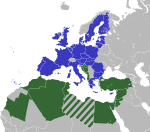
See also Organisation of Islamic Cooperation (OIC) Members Afghanistan · Albania · Algeria · Azerbaijan · Bahrain · Bangladesh · Benin · Burkina Faso · Brunei · Cameroon · Chad · Comoros · Côte d'Ivoire · Djibouti · Egypt · Gabon · Gambia · Guinea · Guinea-Bissau · Guyana · Indonesia · Iran · Iraq · Jordan · Kuwait · Kazakhstan · Kyrgyzstan · Lebanon · Libya · Maldives · Malaysia · Mali · Mauritania · Morocco · Mozambique · Niger · Nigeria · Oman · Pakistan · Palestine · Qatar · Saudi Arabia · Senegal · Sierra Leone · Somalia · Sudan · Suriname · Syria · Tajikistan · Turkey · Tunisia · Togo · Turkmenistan · Uganda · Uzbekistan · United Arab Emirates · YemenObservers Countries and territoriesBosnia and Herzegovina · Central African Republic · Russia · Thailand · Northern Cyprus (as Turkish Cypriot State)Muslim communitiesInternational organizationsMembers and observers of the Non-Aligned Movement Members Afghanistan · Algeria · Angola · Antigua and Barbuda · Bahamas · Bahrain · Barbados · Belarus · Belize · Benin · Bhutan · Bolivia · Botswana · Brunei · Burkina Faso · Burma · Burundi · Cambodia · Cameroon · Cape Verde · Central African Republic · Chad · Chile · Colombia · Comoros · Congo · Côte d'Ivoire · Cuba · Democratic Republic of the Congo · Djibouti · Dominican Republic · Ecuador · Egypt · Equatorial Guinea · Eritrea · Ethiopia · Gabon · Gambia · Ghana · Grenada · Guatemala · Guinea · Guinea-Bissau · Guyana · Honduras · India · Iran · Jamaica · Jordan · Kenya · Kuwait · Laos · Lebanon · Lesotho · Liberia · Libya · Madagascar · Malawi · Maldives · Mali · Mauritania · Mauritius · Mongolia · Morocco · Mozambique · Namibia · Nepal · Nicaragua · Niger · Nigeria · Oman · Pakistan · Panama · Papua New Guinea · Peru · Philippines · Qatar · Rwanda · St. Lucia · St. Vincent and the Grenadines · São Tomé and Príncipe · Saudi Arabia · Senegal · Seychelles · Sierra Leone · Singapore · Somalia · South Africa · Sri Lanka · Sudan · Suriname · Swaziland · Syria · Tanzania · Thailand · East Timor · Togo · Trinidad and Tobago · Tunisia · Turkmenistan · Uganda · United Arab Emirates · Uzbekistan · Vanuatu · Venezuela · Vietnam · Yemen · Zambia · ZimbabweObservers Countries Antigua and Barbuda · Armenia · Azerbaijan · Bosnia-Herzegovina · Brazil · China · Costa Rica · Croatia · Cyprus · Dominica · El Salvador · Kazakhstan · Kyrgyzstan · Mexico · Montenegro · Russia · Serbia · Ukraine · UruguayOrganizations Semitic-speaking nations Second Journey of Paul the Apostle 1. Cilicia · 2. Derbe · 3. Lystra · 4. Phrygia · 5.Galatia · 6. Mysia (Alexandria Troas) · 7. Samothrace · 8. Neapolis · 9. Philippi · 9. Amphipolis · 10. Apollonia · 11. Thessalonica · 12. Beroea · 13. Athens · 14. Corinth · 15. Cenchreae · 16. Ephesus · 17. Syria · 18. Caesarea · 19. Jerusalem · 20. AntiochCategories:- Syria
- Arabic-speaking countries and territories
- Arab republics
- Countries of the Mediterranean Sea
- Eastern Mediterranean countries
- Western Asian countries
- Fertile Crescent
- Levant
- Mesopotamia
- Member states of the Arab League
- Member states of the Organisation of Islamic Cooperation
- Member states of the Union for the Mediterranean
- Middle Eastern countries
- Near Eastern countries
- Socialist states
- States and territories established in 1946
- Western Asia
- Member states of the United Nations
Wikimedia Foundation. 2010.


